FRIDAY
MARCH 15 - 2013
NORE
BARN
Spotted
Redshank
11:15 - Nore Barn.
Tide rising to high water in about 2 hours. Strong SW
wind with heavy showers. Here is my daily check on the
Spotted Redshank. It was feeding with a Greenshank in
the rapidly filling stream when I arrived. The
Greenshank flew off, but the Redshank continued to
feed as the tide gradually filled up the stream. It
was right at the top of the stream near the little
bridge when I left at about 12:15. I asked if it was
coming back next year. I am sure it nodded in reply!
The
Spotted Redshank gave me a nice wave as I went
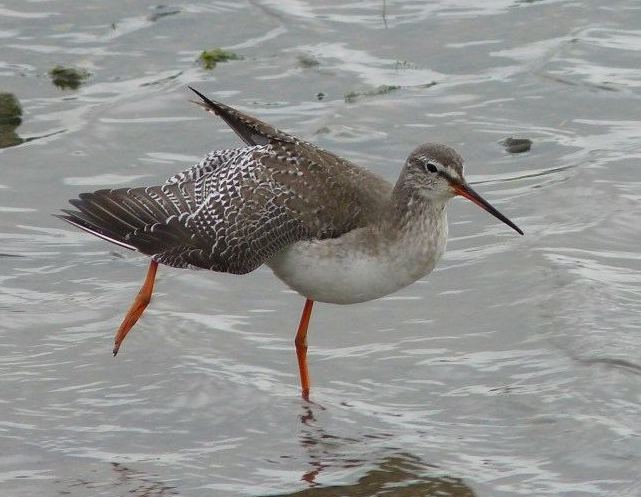
Moulting?
I was interested to
see from some of my photos that the Spotted Redshank
appeared to be losing some of its flight feathers.
This was also evident in some of yesterday's photos.
Consulting my BTO 'Guide to Moult in Birds', I learn
that Spotted Redshank has two moults; one complete
moult post breeding (Jul-Oct) and a partial pre
breeding moult in March to May. This latter one may be
what our bird is currently undertaking, though it does
seem to be an unusual time to moult just before a long
migration.
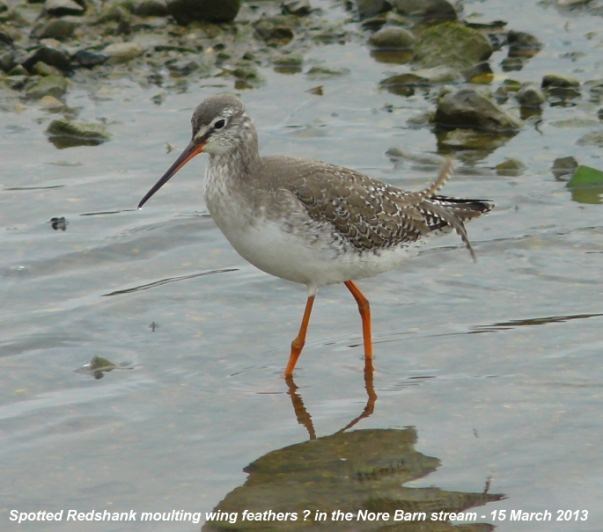
Other
birds
Numbers of wintering
harbour birds continue to fall. I could only see nine
Brent Geese, including 3 juveniles, at Nore Barn, plus
about 50 Wigeon and Teal in the creek.
Hollybank
Woods lichen
Ralph Hollins was very
impressed with my lichen photo from Hollybank Woods
(Mar 13). He says he can safely record it as 'Usnea
spp', but points out there are two similar species
that grow on Silver Birch trees with a clear
difference between the two which is not shown on my
photo. The main stem of U. subfloridana
is black at the base where it joins the tree whereas
the U.cornuta stem is grey/green
throughout. See http://www.irishlichens.ie/pages-lichen/l-46.html
for cornuta and http://www.irishlichens.ie/pages-lichen/l-13.html
for subfloridana. Clearly, the way to decide this is
to go to Hollybank Woods again to check which I shall
do as soon as the weather improves.
There were in fact
several other lichens growing on the Silver Birch tree
on the Holly Lodge clearing. Here is one of them which
is clearly fruticose and my tentative identification
of this is Ramalina farinacea
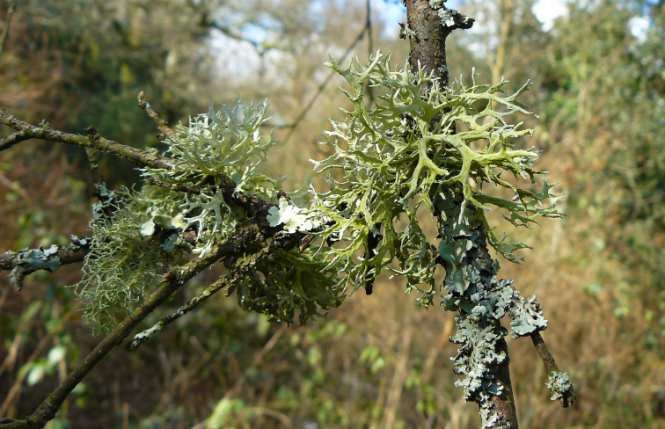
. .
. and a fungus?
Also, growing high up
in the same Silver Birch tree was a bright yellow
growth, which I thought at first was another lichen,
but I am more incllined to go for a fungus, possibly
Yellow Brain Fungus (Tremella mesenterica).
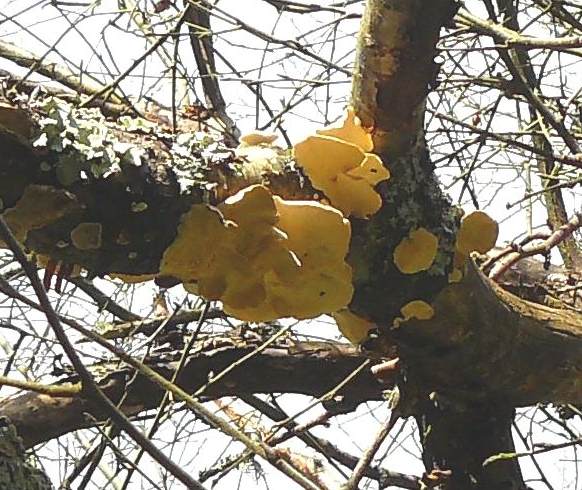
Malcolm's
news
Malcolm Phillips went
round Brook Meadow yesterday and got this smashing
photo of a Water Vole having a snack on the
river by the railway embankment near the tunnel at
about 11.30am.
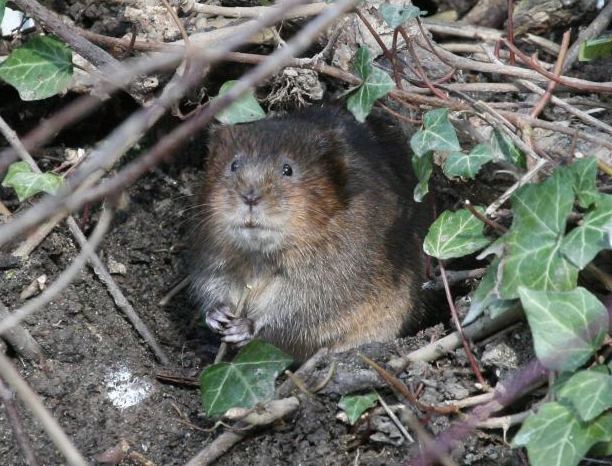
Malcolm went to
Warblington but there was no sign of the Ibis but he
did see 2 Buzzards together over the
castle.
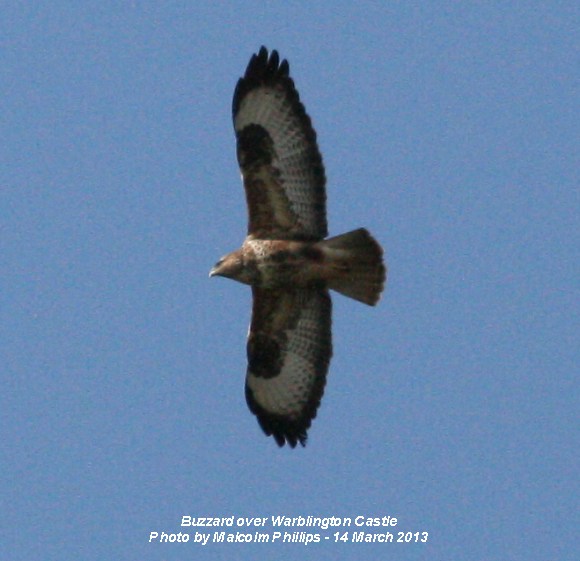
Hayling
Oysterbeds news
Tom Bickerton passed
on this photo of a male Wheatear from Chris
Cockburn that Mike Johnston took near the Oysterbeds
on March 13th.
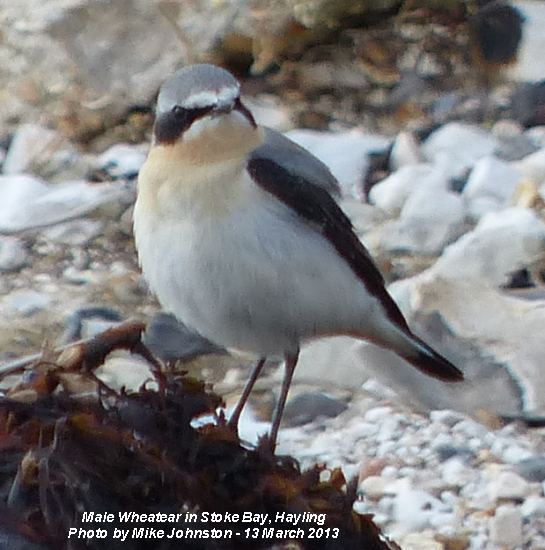
Chris says the same,
or another, bird was in same place on mar 14 on Stoke
Bay beach, just west of 'ye olde sheltering bramble
bush'. Chris watched the first copulation of
Black-headed Gulls and noted a pair of Herring Gulls
sleeping on the eastern island.
THURSDAY
MARCH 14 - 2013
Two
Spotted Redshanks
It was quite late by
the time I got down to Nore Barn today (12.00) and the
tide was almost fully in. The stream was full, but the
ever faithful Spotted Redshank was there all alone,
snoozing near the boats moored on the shore. I watched
it for about 30 minutes as the water crept higher and
higher; it was quite unfazed by people and dogs
walking nearby. As shown in the photo the bird's
plumage is darkening noticeably with the white tips to
the feathers starting to show as spots of the breeding
plumage.
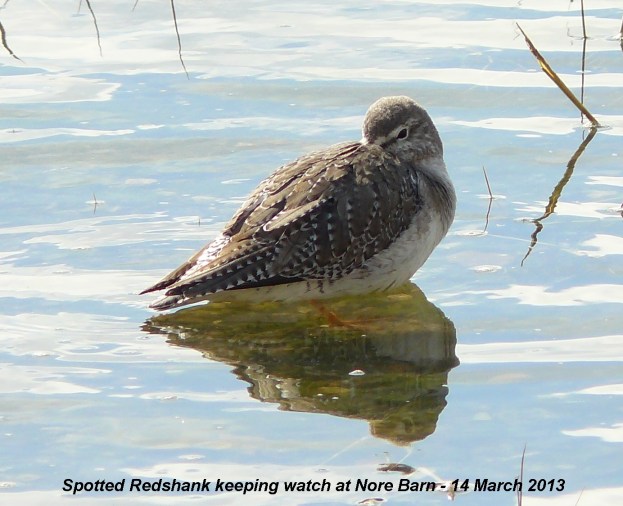
Eventually at around
12.30 it flew onto the saltmarshes on the western side
of the stream. When I looked over to see where it had
landed I realised it had joined a second Spotted
Redshank that had presumably been snoozing on the edge
of the saltmarshes all the time. I left at about 12:45
and I assumed the two birds would be roosting there
over high water.
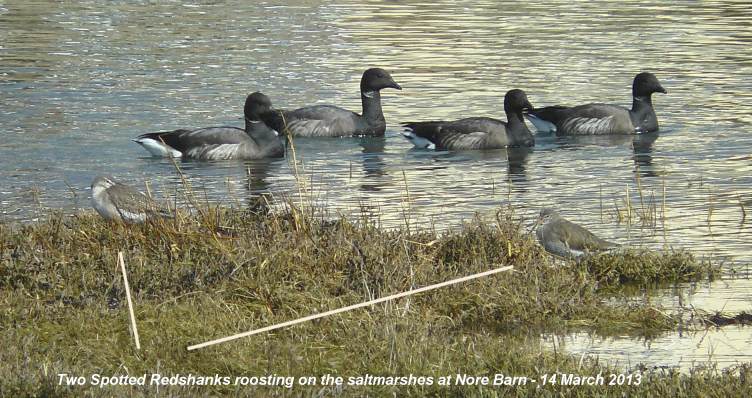
Garden
Siskins
Siskins continue to
visit the garden of Caroline French; amazingly, she
had six on Monday. They were mainly feeding on
sunflower hearts, but one did take niger seed.
Caroline says for a small number of birds they make a
surprising amount of noise with their cheerful
chattering in the tree. Here is Caroline's photo
showing both female and male on the feeder.
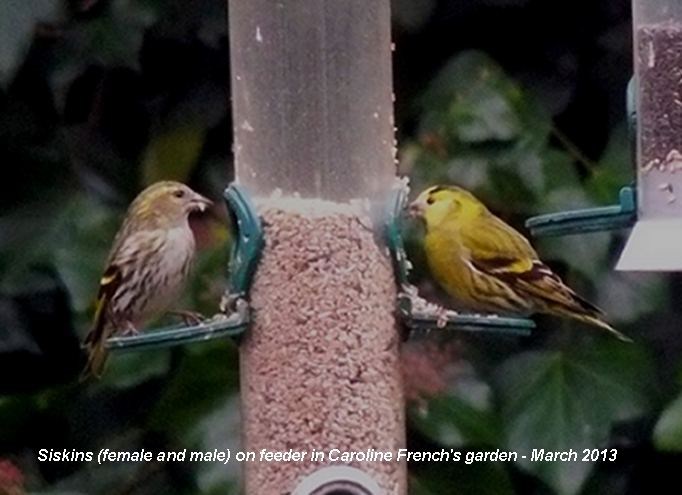
Warblington
Wagtail
Malcolm Phillips photo
of the Wagtail at Warblington Farm on March 12
prompted two comments, both of which prefer Pied
Wagtail rather than White Wagtail. I am inclined to
agree with them (not that I am any sort of expert on
Wagtails!).
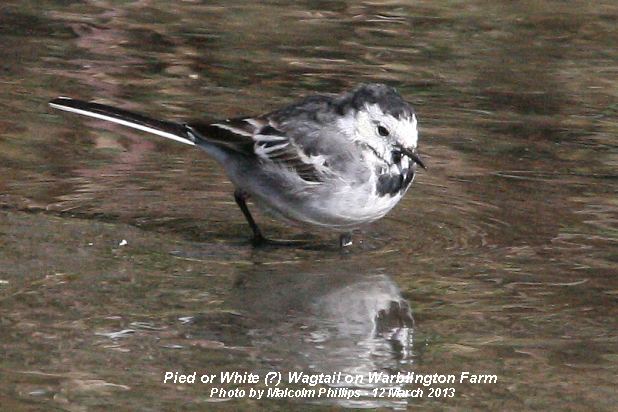
Tom Bickerton
says . . . "Very difficult from this image, I'm
erring for this one on Pied Wagtail. I thought the
first image (Mar 4) looked pretty good for a White
Wagtail. The trouble is these birds are in moult,
that's why a good look at the back and tail gives an
indication. We usually get the birds that breed
further North, so it's not impossible, but more likely
to see them in the Autumn."
Peter Milinets-Raby
says . . . " Again, I do not think it is a White
Wagtail, but what do I know. I always believe that if
it is what you think it is, it will jump out at you.
This does not 'jump'. A White Wagtail is very pale
grey and very clean white underneath and stands out
like a soar thumb! The following reasons spring to
mind: The median coverts are black centred and white
edged. Too dirty grey on the flanks (White Wagtails
look white and very grey - not black and white) There
seems to be dark feathers in the mantle."
Local
Ravens
In his Spring Notes in
the current Newsletter of the Friends of Stansted,
Head Forester Michael Prior indicates that the winter
visiting Ravens have been very noticeable with up to
four birds being seen in Stansted Park some days.
Ralph Hollins also points out that Ravens are
regularly reported from Thorney Island, Hayling,
Portsmouth and Farlington Marshes and they have been
known to nest in the Racton Folly. So, please keep
looking up for big birds!
WEDNESDAY
MARCH 13 - 2013
NORE
BARN
I popped down to Nore
Barn this morning by 10am on a rising tide to check on
the Spotted Redshank which was in the stream as
usual. It is now later now than it was last year when
it had gone by Mar 9, but there is still some way to
go to beat the record of 24 March 2010. An unringed
Greenshank was feeding in the pond in the wet
field at the top of Nore Barn Creek. The only other
waders I noticed were a Common Redshank and a Grey
Plover.

There was not much
else at Nore Barn, but for a sprinkling of Brent
Geese, Wigeon and Teal. I was interested to see
four juveniles in the group of 20 or Brents, which
were probably the families of 2, 1 and 1 that I have
been seeing from time to time during the winter. Are
the families the last to leave I wonder?
HOLLYBANK
WOODS
Although it was very
cold, a hint of sunshine from time to time prompted me
to head for the woods to see if I could find any
butterflies. Brimstone and Comma should be emerging
from their hibernation about now and could be about.
However, there were none at all! I walked through both
the eastern and western sections without seeing a
single butterfly! I met Andy Brook who told me
Brimstone had been seen in the woods this year along
with the regular Speckled Woods.
There was a regular
conservation work session taking place (Wednesdays and
Fridays). The main job was coppicing the Sweet
Chestnut in the area to the west of the main path.
Here is the group of volunteers busy at work.
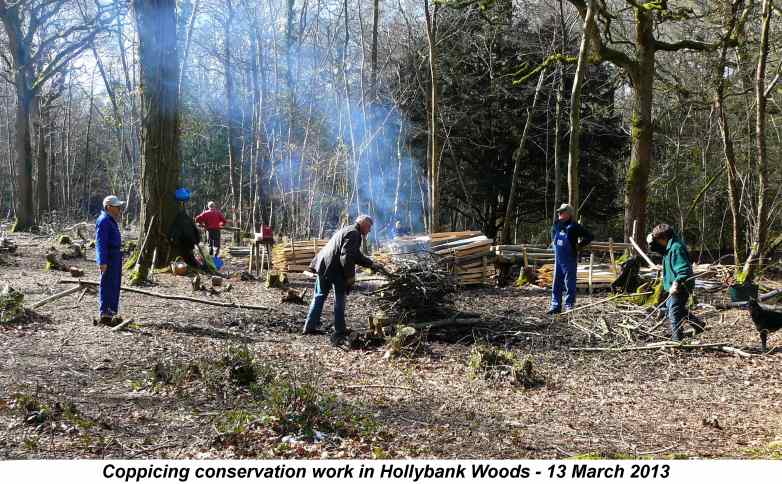
The group have also
constructed a number of pedestrian friendly hurdle
gates, mainly to restrict access of horse riders
and motorcyclists through the main woodland. I think
these are a very good idea and create a more 'walker
friendly' feel to the woods.
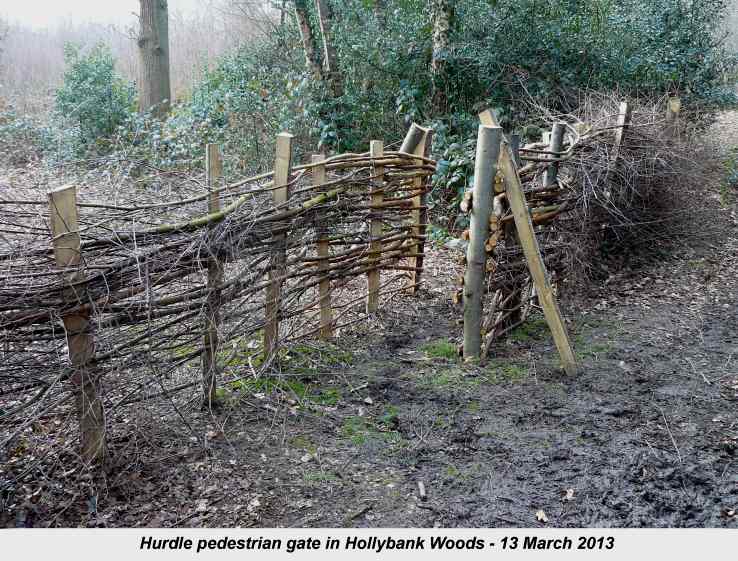
The woods were very
quiet on the bird front. A Nuthatch was singing
noisily from near the southern entrance to the woods.
The only other birds heard singing were Robin, Great
Tit, Woodpigeon, Green Woodpecker and Stock Dove. I
saw Long-tailed Tits working their way through the
trees.
Lichen
- Usnea subfloridana?
I found a good variety
of lichen growing on an old Silver Birch tree on the
Holly Lodge clearing.
Here
is one example of a fruticose lichen which I
tentatively identify as Usnea subfloridana
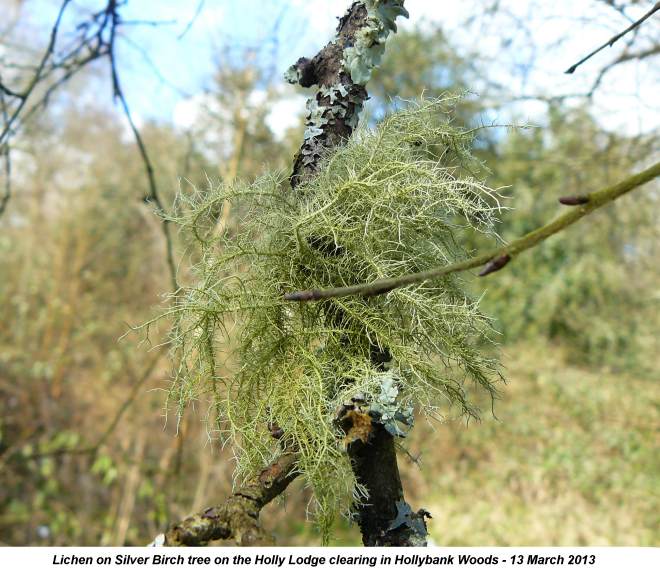
Ralph Hollins checked
my photo against those in the Irish Lichens web site
as well as the Lastdragon web site and in doing so
found an obvious(??) difference between U.
subfloridana and U. cornuta
which is another common species that also grows on
Birch. Ralpgh says my photo and the majority of those
available on the web do not show this feature which is
that the main stem of U. subfloridana is
black at the base where it joins the tree whereas
U.cornuta stem is grey/green
throughout
see . . http://www.irishlichens.ie/pages-lichen/l-46.html
for cornuta and http://www.irishlichens.ie/pages-lichen/l-13.html
for subfloridana - the first photo here shows the
blackening very clearly). The best way to decide this
is to go to Hollybank Woods again to check.
BROOK
MEADOW
Malcolm's
news
Malcolm Phillips went
round the meadow for half an hour this morning. There
was not much movement but he did see the Great Spotted
Woodpecker at the north east corner. He returned at
11.45am and, after a while, saw a Water Vole
having a snack by the sluice gate. Interesting to
see the damage to fur on the animal's back, like we
have seen many times before. A sign of fighting.
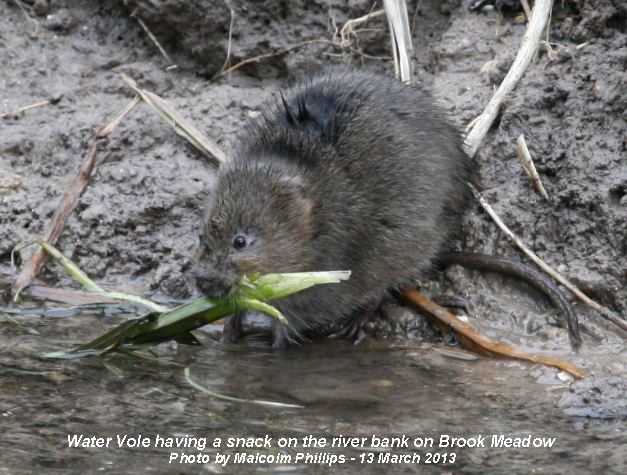
Finally, the
Firecrest which has been OWOL for the past 10
days or so, finally showed up, though not well enough
for photo. But, at least we know that one of them is
still here.
Buzzard
I met Pam Phillips at
Nore Barn who told me that she too had seen a Buzzard
in trees on Brook Meadow on several occasions during
the past week from her bedroom window in The Rookery.
Pam can see the Lumley area of the meadow from her
window.
Water
Rail in snow
Yesterday (Mar 12)
Nick Haigh had a cold morning, but very worthwhile
morning on Brook Meadow. He got good views and photos
of his first ever Water Rail in the snow, on the west
bank of the river just south of the S-bend. Nick also
had the pleasure of seeing his first ever Firecrest
the other week after bumping into Malcolm Phillips on
Brook Meadow and being shown the best spot. Nick's
conclusion was, "A great patch and worth the trek from
Southampton".
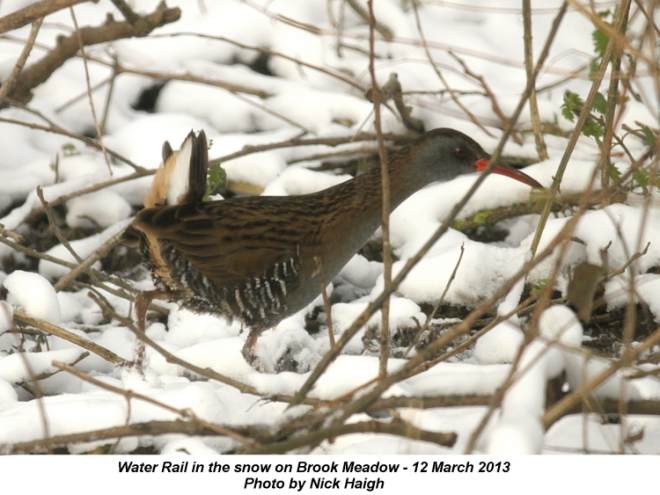
TUESDAY
MARCH 12 - 2013
Buzzard
on Brook Meadow
On my morning
constitutional through the meadow I met Mike Wells on
the main river path with camera at the ready, but he
had not managed to catch anything as yet. He had just
got back from a very cold Budds Farm where he had seen
the two Scaup on the ponds. Mike told me he had seen a
Buzzard on the meadow yesterday being hassled by two
Carrion Crows. This was our second Buzzard sighting in
a week, suggesting a more regular visitor like we had
in February 2010.
New
nest box on Peter Pond
Here is a photo of
David Gattrell's new covered nesting box which is
sited on the floating raft in the centre of the pond.
Previously, David has tried similar raised nest boxes
on poles in the pond itself with not much success.
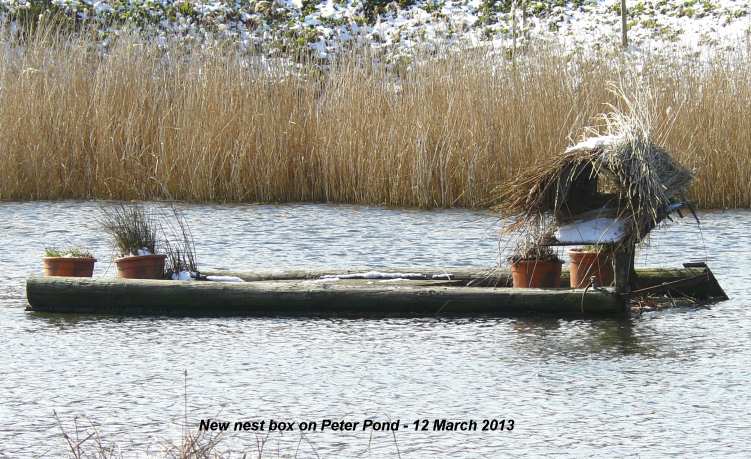
Great
Black-backed Gulls
The pair of Great
Black-backed Gulls were on the centre raft when I
walked round this morning. One of the birds (female?)
was settled down on a flat area of the raft with twigs
evident, though I cannot for certain say it was a
nest.
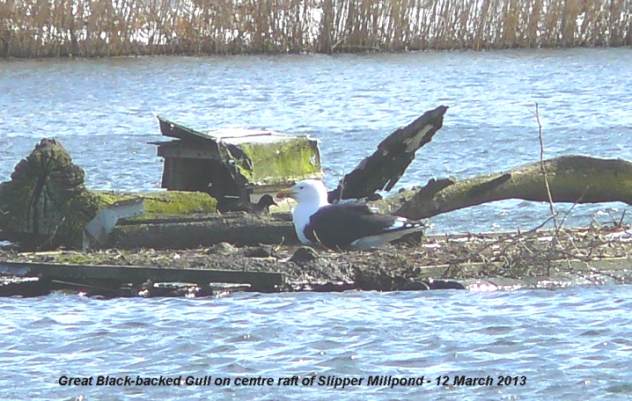
Many of the
Black-headed Gulls were in breeding plumage and one
needs to look closely to make sure they are not
Mediterranean Gulls.
A
perky Robin
Malcolm Phillips had a
walk round the meadow early afternoon, but there was
not much in the way of bird activity on this very cold
day. The only photo he got was one of a perky
Robin on the river bank.
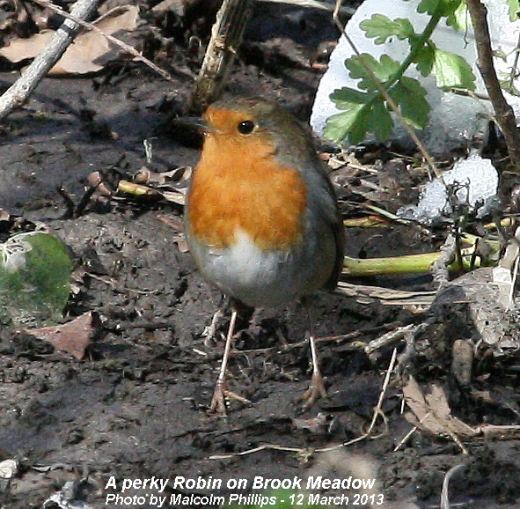
Wagtail
at Warblington
Malcolm then went over
to Warblington Farm where he found the Glossy Ibis in
the usual field east of the cemetery extension along
with the regular Curlew. Malcolm also saw a Wagtail
in the field, but is it a Pied or a White? I am
definitely not prepared to say which Wagtail this is
as there was some dispute over the last one that
Malcolm snapped here on Mar 4. However, here is
Malcolm's photo of today's bird for you to ponder
over.

Buzzard
Malcolm wondered why
the birds kept running for cover and found the answer
when he looked up and saw a Buzzard. This is
probably one of the birds that regularly nest on
Warblington Farm.

MONDAY
MARCH 11 - 2013
EMSWORTH
Snowfall
I went for a walk in
the snow this morning, through Brook Meadow to The
Rookery where I delivered the fortnightly Brook Meadow
e-mail notes to Ted and Penny Aylett as I usually do.
The snow was light but the wind was strong and cold
which made birdwatching impossible. However, I enjoyed
taking a few snaps of the snow including the favourite
view of the River Ems from the south bridge.
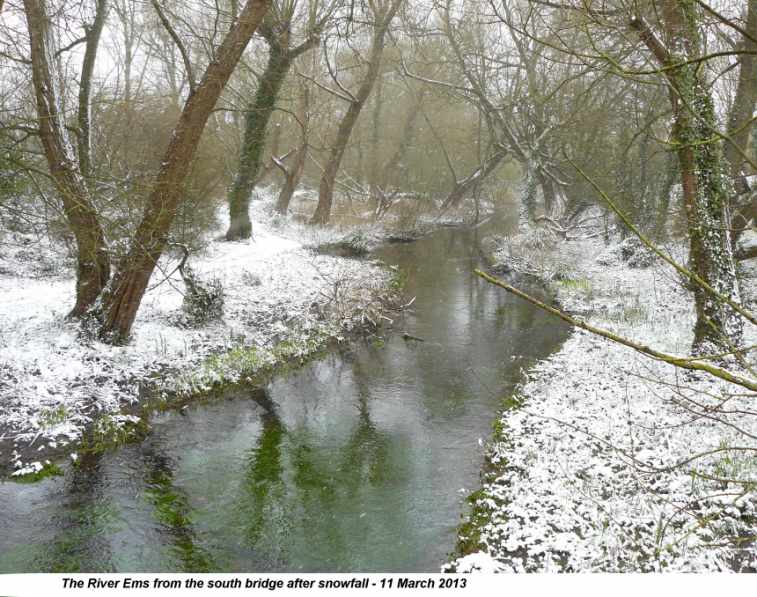
Here is a Daffodil
full of snow with Crocuses in the background in a
garden in The Rookery.
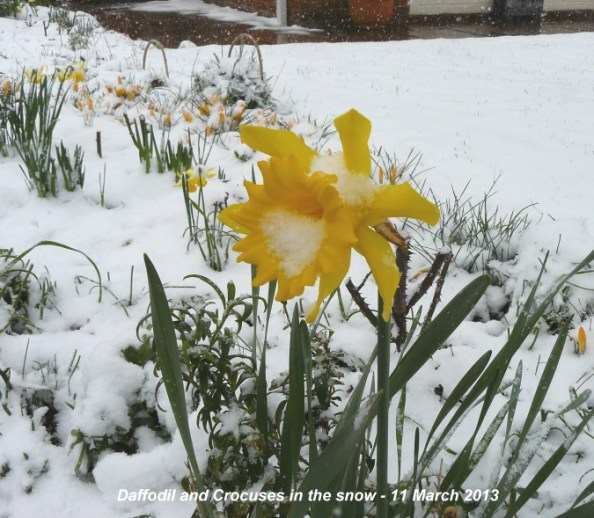
I found the pair of
Great Black-backed Gulls hunched up against the snow
on the centre raft on Slipper Millpond
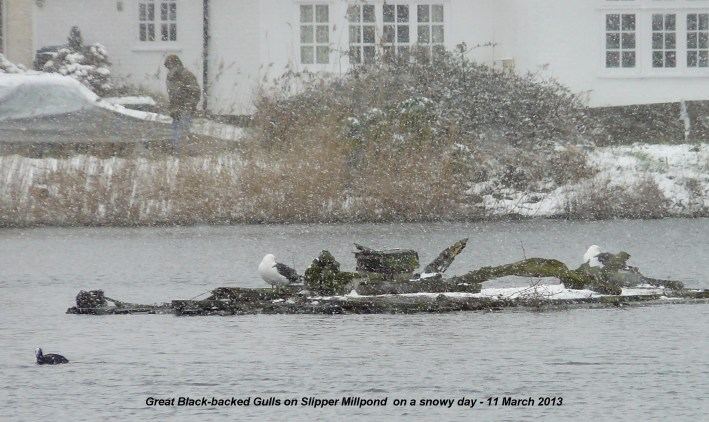
Malcolm Phillips was
also on the meadow today and got this image of the
path through Palmer's Road Copse after the snowfall.
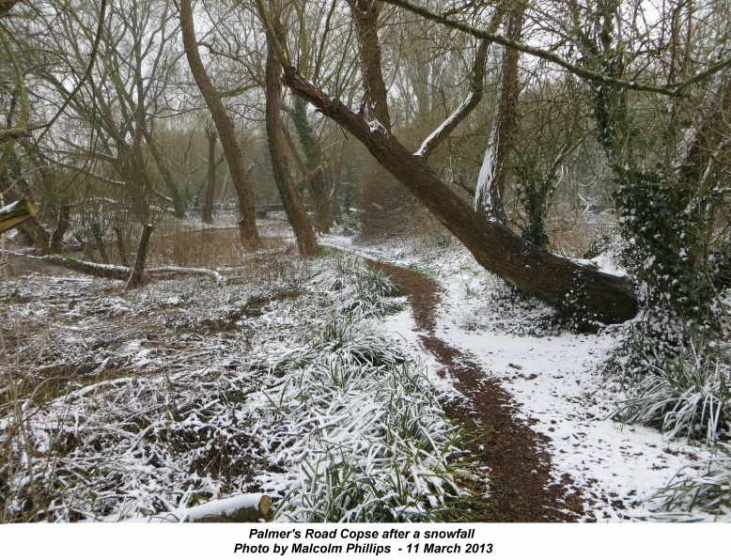
GARDEN
BIRDS
Black-headed
Gulls
As often happens when
it snows I get some uncommon birds turning up in my
garden. This morning I had two Black-headed Gulls, one
of which was a juvenile. They remained on the bird
table for a few minutes, which is quite unusual as
they usually just swoop down and go. This enabled me
to get my camera out and take a few photos.

My last sighting of
Black-headed Gulls was in January also during a snowy
spell, though I rarely get more than one visit each
year. Black-headed Gull is ranked 32nd in the BTO
Garden BirdWatch scheme for this region at this time
of the year with a reporting rate of just 4.6%.
Pied
Wagtail
The other surprising
bird was a rather fine Pied Wagtail which came and
went several times from the bird table where it was
taking seeds and chopped peanuts.
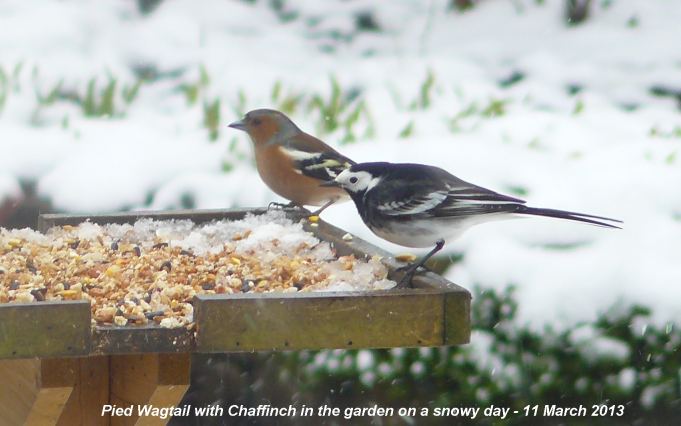
I have only 6 previous
records of Pied Wagtail in my garden going back to
1997 when we first moved into Bridge Road. All
sightings were in the winter period from Nov-Feb and
the last one was in November 2010 (the others were
February 2009 January 2008 February 2003 January 2000
December 1998 December 1997). Pied Wagtail is
generally a more common garden bird than Black-headed
Gull. It is ranked 25th in the BTO Garden BirdWatch
scheme for this region at this time of the year with a
reporting rate of 15%.
OTHER
NEWS
Mandarin
Ducks
Regarding the four
Mandarin Ducks that Barry Kingsmith had on his garden
pond on Mar 8, Ralph Hollins says there is a
distribution map on the DEFRA web site indicating the
10Km Squares in which the species has been recorded,
which is almost everywhere in Britain from Lands End
to John O'Groats. Ralph adds, "The spread of this
non-native species is of little concern to DEFRA since
the only known impact of these duck on other wildlife
is that they compete for tree hole nest sites with
Jackdaws and Grey Squirrels. from http://ralph-hollins.net/Summary.htm
Ralph was right about
them not staying since Barry told me they flew off as
soon as they saw his camera and have not returned.
Mute
Swans wandering
Mute Swans do tend to
wander into dangerous situations at this time of the
year as their hormones get the better of them. Malcolm
Phillips came across this pair being shepherded across
the busy main road through Emsworth.
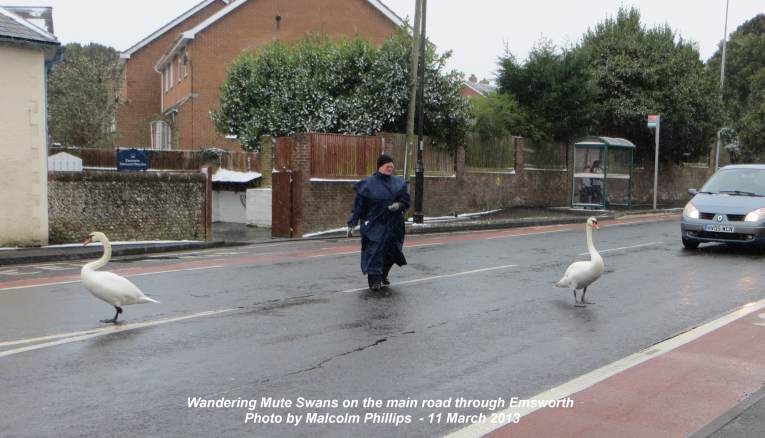
Garden
sightings
Rod and Angela Storey
(new contributors to the Emsworth Comminuty Wildlife
web site) sent me recent garden sightings from their
home in North Emsworth. Green Woodpecker visits
roughly twice a day since January especially if wind
from north or north west. It stays stays 20 to 30
minutes, pecking in the lawn. It is likely to be
looking for ants which it catches with its long sticky
tongue. Goldcrest has been seen twice since 1st
March, in front garden on large very bushy rose tree.
It is probably hunting for small grubs and other
invertebrates. Willow Warbler seen since last
summer, but still appears to be around, although
supposed to be a summer visitor. This is almost
certainly a Chiffchaff, which is virtually
identical to a Willow Warbler, but some of them do
over winter. Frog spawn in garden pond 7th
March.
Derek and Heather
Mills have had a male Blackcap coming regularly
to their feeder for a few weeks. Heather also makes
sponge cake for him as well as providing ample suplies
of sunflower hearts, apple and nijger seed. That bird
knows where he is well off.
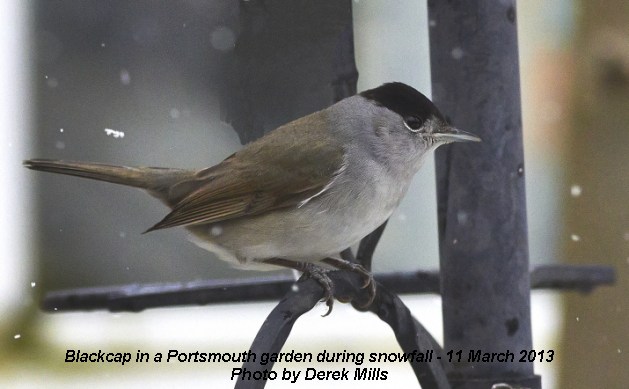
SUNDAY
MARCH 10 - 2013
BROOK
MEADOW
Water
Voles
Malcolm Phillips had a
quick walk round the meadow this morning. He saw a
Water Vole swimming by the observation fence at 9am.
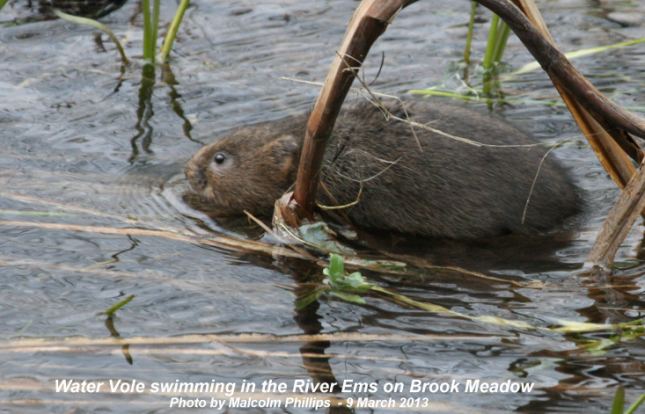
Graham Petrie was
excited to see his first ever Water Vole on Brook
Meadow today, not the best sighting but a definite. He
said it was smaller than expected and was actually
spotted by his partner Christina on her first visit to
the meadow with their little boy. It scurried along
the north bank about 20 metres west from where the
River Ems comes under the railway line, then settled
down about a metre back in the reeds for a minute or
so before disappearing back completely out of sight.
Interestingly, this is Section A1 for Water Vole
sightings and only the second one there this year.
Graham provided the
following link to an interesting video about the
restoration of habitat for Water Voles on a Dorset
river. . . http://www.bbc.co.uk/news/science-environment-21711791
Has
Firecrest gone?
Malcolm could not find
the Firecrest anywhere and wonders if it could have
moved on. Our last sighting of the Firecrest was over
a week ago on Mar 2, which clearly suggests the
bird(s) have left. But what an experience it has been
while they have been here. So easy to see and giving
people such great pleasure as well as splendid photos.
Farewell Firecrests, and fare forward!
The Firecrest(s) were
on Brook Meadow for about two months. The first
sighting was in north west corner of Brook Meadow on
Jan 3. The bird then moved to its favoured spot near
the observation fence on Jan 15. On Feb 1 we got
photos of what looked like male (with orange crest)
and female (with yellow crest), but I am now doubtful
about the female identification which relied entirely
on photos which can easily mislead. We had several
sightings during February of two males, which I think
was what we had.
Water
Rail
Brian Lawrence got a
good view of the Water Rail this afternoon with the
following photo. So, that bird is still with us at
least!

OTHER
NEWS
Night
time songster
Caroline French woke
in the middle of the night one day last week to hear a
Robin singing heartily outside the front of her house
in North Emsworth. It was singing from 2.10am for at
least an hour and a second Robin was also singing
somewhere nearby. Caroline says she has heard of urban
birds singing at night but this was the first time she
had experienced it. There is a bright streetlamp just
outside her neighbour's house. In the spring, urban
Robins singing at night are often mistaken for
Nightingales. Do any other birds regularly sing at
night I wonder? Blackbird possibly?
Raven
sightings
In view of the recent
discovery of Ravens nesting on Portsdown Hill, I
thought it would be useful to keep a record of local
Raven sightings. At about 8am on Mar 6 this year, I
saw from my bedroom window what I am fairly sure was a
Raven flying north across the gardens - my first ever
in Emsworth. Other recent local sightings included a
pair by Peter Milinets-Raby flying south west over his
Havant garden on 12-Dec 2012. On the same day, Tony
and Hilary Wootton were walking around Walderton when
they saw two Ravens hassling a Buzzard over Inholmes
Wood, possibly the same birds. Tony also saw two over
Thorney on 16-Nov-12, where Richard Somerscocks also
saw one on 12-Apr-12 and got a photo of the bird as it
flew over. So, keep looking out and up for these
magnificent birds. Please let me know any records I
might have missed.
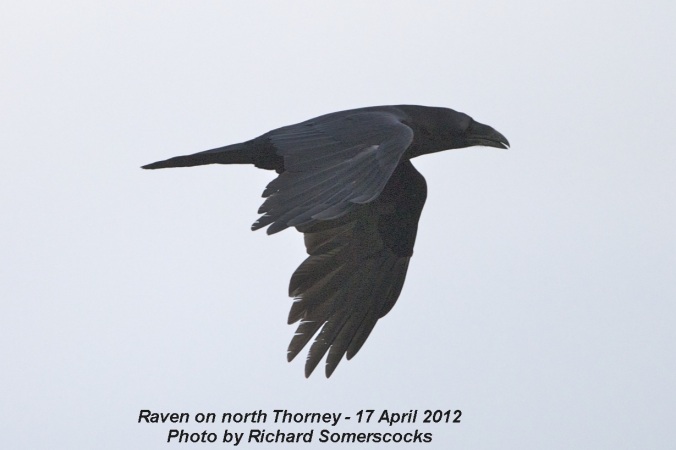
SATURDAY
MARCH 9 - 2013
CHICHESTER
GRAVEL PITS
Having an hour or so
to spare this morning while Jean did some shopping in
Chichester, I had a walk along the main track through
the gravel pits. Ivy Lake was, as usual, crowded with
mainly Coot and Tufted Duck, though I suspect numbers
are down on midwinter as the birds start to leave for
breeding areas further north. The Great Crested
Grebes were looking superb in their finery, though
I did not catch any displaying.
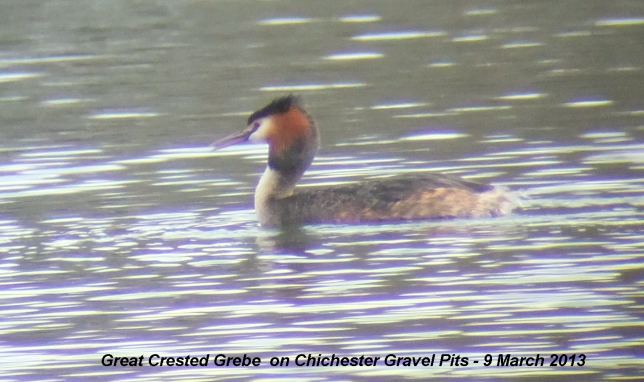
Pochard were very
scarce with only about half a dozen seen, though I did
not look at New Lake where most of them tend to
reside. I counted just 16 Gadwall on Ivy Lake, though
again there could well have been more on the lakes
towards Vinnetrow.
I would estimate about
50 Canada Geese scattered around the lakes. Among the
group on East Trout Lake was the white-faced Canada
Goose which I last saw in Emsworth Harbour on
29-Jan-2012. The usual group of tame Greylag Geese
were on the far shore of Copse Lake.
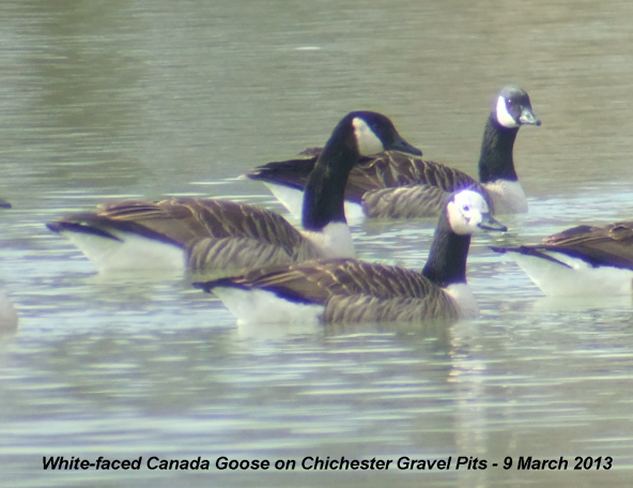
There were lots of
immature Herring Gulls on Ivy Lake along with some
Lesser Black-backed Gulls and a pair of Great
Black-backed Gulls. I had a good look for the Bittern
that the Havant Wildlife Group saw last week in the
reedbeds on West Trout Lake but there was no sign of
it. I saw my first Coot with its nest on the
side of Ivy Lake.
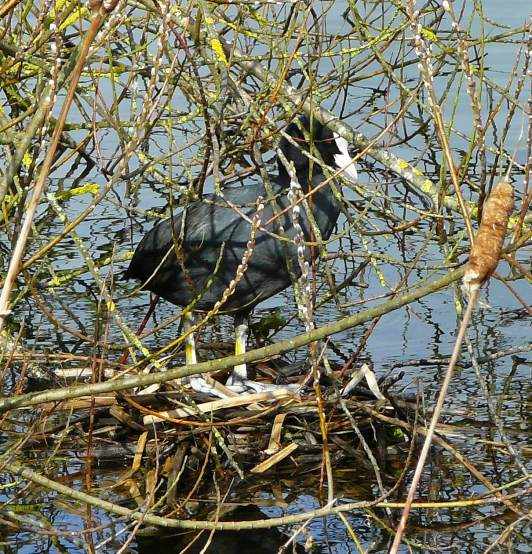
I was pleased to see
my first Coltsfoot flowers of the year along
the path by Ivy Lake, though I suspect they have been
out for a while.

BROOK
MEADOW
Malcolm Phillips saw
his first Kingfisher in the meadow today. He
was taking photos of the Water Rail by the observation
fence when the Kingfisher flew south, too fast for a
photo though.
Water
Voles
He had another good
day for Water Voles with three sightings: first one by
the sluice gate going north at 10am, the second by the
deep water sign going south at 10.45am, the last was
by the south bridge at 12.15pm. Here is Malcolm's
photo of one of the voles having a snack.
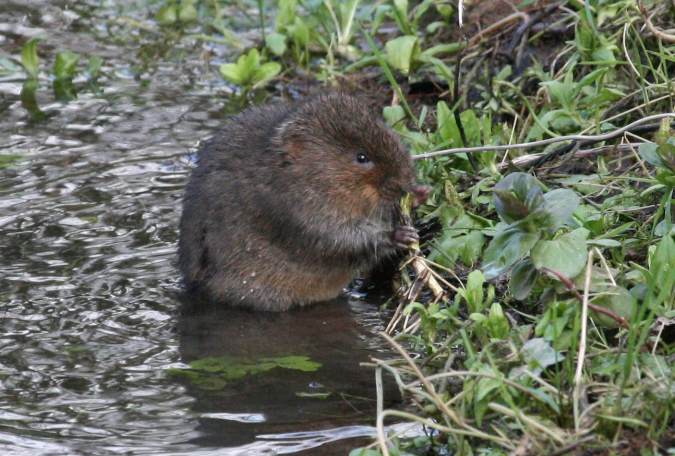
Water
Rail
The Water Rail was out
in the open quite a long time today so Malcolm managed
some good photos.
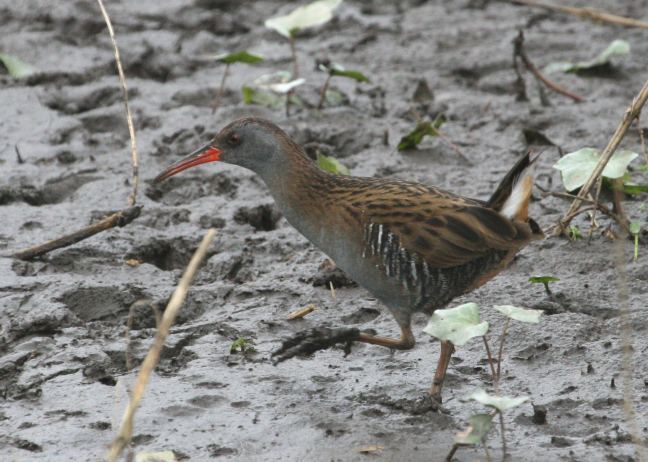
He also got a good
shot of a Wren bathing in the river.
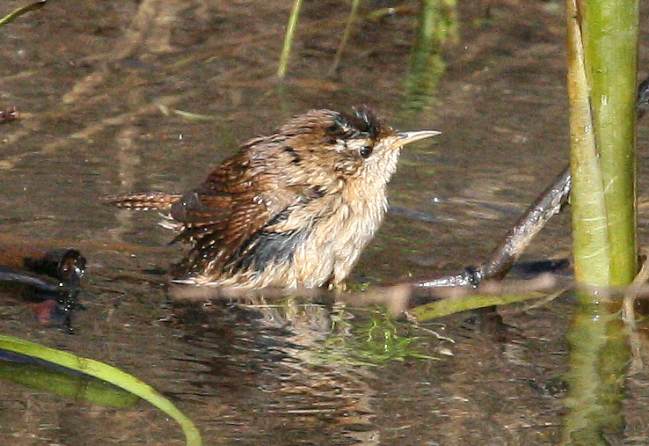
NUTBOURNE
- PRINSTED
Caroline French
reports on this morning's walk by the Havant Wildlife
Group. Go to . . . Havant
Wildlife Group
FRIDAY
MARCH 8 - 2013
Ivy-leaved
Speedwell flowers
While walking
alongside the A259 embankment wayside into the village
this morning, I noticed Ivy-leaved Speedwell in flower
at the western tip of the wayside. This was my first
of the year, though I see Ralph Hollins found his
first Ivy-leaved Speedwell flowers in Havant on Feb 5,
so they have probably been out for some while.
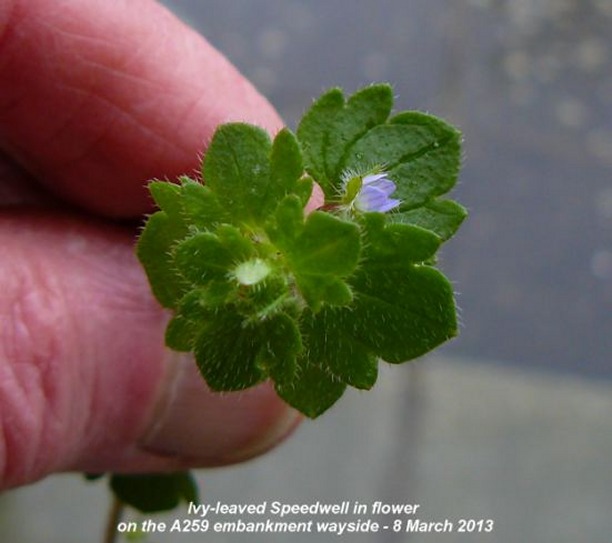
This is a more or less
prostrate hairy annual with ivy-shaped leaves.
According to Blamey, Fitter and Fitter (p.242) its
flowers are either blue (ssp hederifolia) or lilac
(ssp lucorum), the latter being the most frequent,
though Rose (New Ed) just says they are pale lilac.
The flower on the sample I picked from the wayside
this morning looked blue to me though I must admit I
am pretty hopeless on colours. When I compared my
flower with the chart on the Wikipedia web page, it
seemed to match best the colour labelled 'pale lilac',
so maybe Rose is right. See . . . http://simple.wikipedia.org/wiki/Lilac_%28colour%29
The Hants Flora states
that Veronica hederifolia ssp lucorum is frequent and
locally common, though says no attempt has been made
to map the two subspecies.
Stock
Dove in garden
We had an unusual
visitor to the garden this afternoon in the shape of a
Stock Dove. It remained in the garden for about 10
minutes feeding with three Woodpigeons. I took some
photos through the window which show the main features
of the bird; a green iridescence around the neck (but
no collar), two black bands on the wings, dark
gentle-looking eyes and a pink yellow tipped bill.
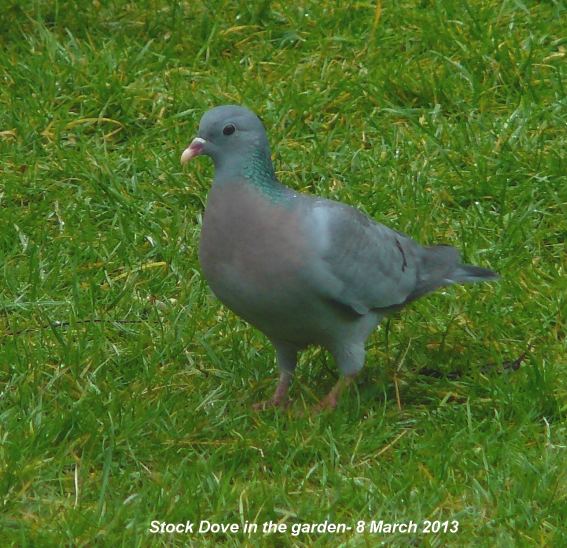
I often hear Stock
Dove singing its 'ooo-wu' song in the Brook Meadow
area and elsewhere. However, my only other sighting of
Stock Dove in my garden was in 2009 when I had two
sightings, the first on Jan 19 and the second on May
1. The BTO does not publish data for Stock Dove in the
Garden BirdWatch scheme, though I suspect the
frequency is fairly low in gardens.
Generally, following
release from the lethal and sublethal effects of the
organochlorine seed-dressings used in the 1950s and
early 1960s, Stock Dove populations increased very
substantially, but then levelled off in the early
1980s, and entered a further increasing phase in the
early 1990s. Recent indices suggest that numbers have
fallen significantly in the last few years.
Siskins
Caroline French
continues to get Siskins in her north Emsworth garden.
She had another visit from a pair this afternoon as
shown in the photo. Siskin ranks 23rd in the BTO
Garden BirdWatch league table for this area at this
time of the year with 21% of participants reporting
them.
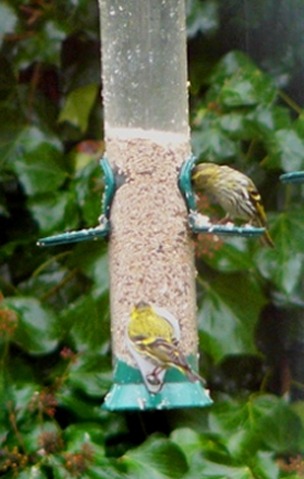
Mandarin
Ducks
Barry Kingsmith sent
the following photo of what must be one of the rarest
garden birds - four Mandarin Ducks (three males and a
female) sitting on the jetty of his pond at Racton
this evening.
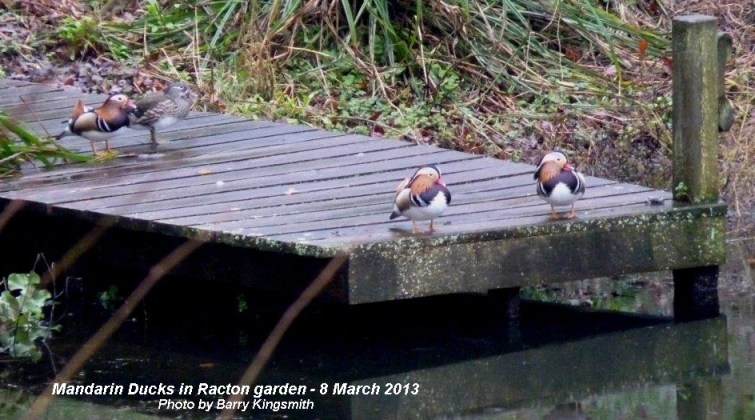
Peter's
walk to Warblington
Peter Milinets-Raby
chose a pretty wet day for his regular walk to
Warblington, starting at Nore Barn at 7:35am and
finishing roughly two hours later. He went along the
shore to Pook Lane, then passed the church to check
all the fields. Peter's photo of unidentified buds
covered with rain drops sums up the weather.

Despite the weather
Peter had a very good haul of birds. The highlights
were as follows:
Adult winter Little
Gull on the water at Conigar Point, before flying
east. 2 Sandwich Terns feeding off the point
(both winter plumaged birds). Whimbrel heard
calling off Conigar Point but too misty and wet to
see!! Brent Geese (Nore Barn - 119, Conigar
Point - 147, Pook Lane - 147), Wigeon (Nore
Barn - 61, Conigar Point - 71, Pook Lane - 167),
Teal (Nore Barn - 77, Conigar Point - 120+,
Pook Lane - 10). Spotted Redshank in the
stream, Greenshank on the pond at the end of
Nore Barn Creek. Med Gull at Nore Barn, 8
Pintail, 2 female Goldeneye and 4 Red
Breasted Mergansers at Conigar Point,
2 Med Gulls, 13
Oystercatchers in a field south of the cemetery (A
must watch field?), Glossy Ibis in the usual
field along with Curlew, 4 Teal and Little Egret. This
field, plus a few others are superb for birds and
should be watched daily - no wonder stuff has been
found since the Ibis turned up. The whole area (away
from Nore Barn) is under watched.
3 Chiffchaff
seen in various hedgerows (possible sign of early
migration, but more likely wintering birds moving). Up
to 5 Pheasant. A pair of Bullfinch along
Pook Lane and 2 Siskin over. 22 Stock
Doves and 3 Med Gulls in the field off the
main Emsworth Road. Only found 5 Curlew feeding in the
fields, so where the other 40+ were was anybody's
guess!
THURSDAY
MARCH 7 - 2013
BROOK
MEADOW
I was greeted by the
cheery song of a Great Tit at the north bridge.
Chaffinch was also singing nearby and a Song Thrush
was sounding off in the north west corner near the
railway embankment. I heard another Song Thrush on the
east side of the meadow and the yaffling call of a
Green Woodpecker from the Lumley area. A Greenfinch
was churring near the Lumley gate. A Blackbird was
serenading in Palmer's Road Copse. They are now
singing generally. Dunnocks were chasing each other
with flicking wings.
Marsh-marigold
is starting to flower on the river bank in its regular
spot in Palmer's Road Copse. This is about 2 weeks
earlier than in previous years.

Slipper
Millpond
The pond was very
quiet with the male Mute Swan patrolling his
territory. I was interested to see a line of white
feathers along the western edge of the pond, probably
the result of some recent Mute Swan skirmishes. There
was just a pair of Herring Gulls along with a dozen or
so Black-headed Gulls.
I found for the first
time what appeared to be some Lesser Periwinkle
in flower on the eastern side of the pond, immediately
opposite the entrance to the caravan park. Its leaves
were hairless which distinguished it from the more
common Greater Periwinkle (Rose New Ed p. 352).
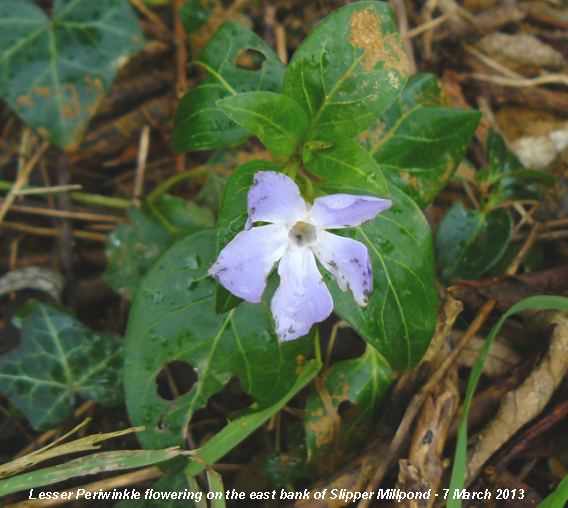
OTHER
NEWS
White
Wagtail -
comment from Ralph Hollins
Regarding the White
Wagtail at Warblington Farm, Ralph Hollins confirmed
this was another new bird for the site. However, he
said Malcolm's photo of the bird (Mar 4) was certainly
not a male, which is unmistakable, but the paleness of
the back plumage makes it most likely to be a
continental female.
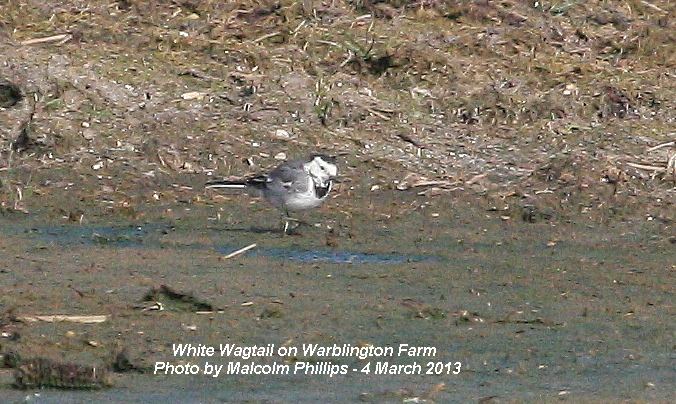
However, this is a
good early record as the first report of White Wagtail
seen elsewhere was at Portland on Mar 4. See the web
site at http://www.portlandbirdobs.org.uk/aa_latestnews.htm
for good photos of White Wagtails. Although the
numbers of White Wagtails in Hampshire which I quoted
in the Mar 4 entry seems small Ralph is pretty sure
that quite large numbers pass through southern England
in both spring and autumn, but as it is difficult to
pick out the continental birds in a mixed flock
(especially in flight) the birds are lumped together
as 'alba Wagtails'.
Osprey
decoys - from
Ralph Hollins
The Osprey decoys on
the landing lights on the east side of North Thorney
were the idea of Roy Dennis of the Highland Wildlife
Foundation who is probably the UK's most experienced
expert on Ospreys. For more information go to Roy's
web site at . . . http://www.roydennis.org/animals/raptors/osprey/nest-building/
Conservancy staff
- from Ralph Hollins
Chichester Harbour
Conservancy has a page on its website with the photos
and job titles of all its staff including a nice shot
of Barry Collins who is now based at Eames Farm and
has the official title of 'Eames Farm and North West
Deeps Warden'. See http://www.conservancy.co.uk/page/people/462/
Glossy
Ibis is
still present on Warblington Farm. In top corner close
to hedge of field behind cemetery extn . Took off and
circled several times before returning to original
spot after being flushed by Sparrowhawk.
Two
Scaup still
present on Budds Farm Ponds yesterday. News from HOS -
http://www.goingbirding.co.uk/hants/birdnews.asp
Farlington
news - from
Bob Chapman
The Red-breasted
Goose was there again and that there were two
Spoonbills, in fact there were a few of these
along the coast today so they must be on the move,
probably to Holland after wintering in western France
and Iberia.
Godwit
News - from
Pete Potts
Following my report of
up to 250 Black-tailed Godwits feeding in 'Texaco Bay'
at North Hayling, Pete said he had also been counting
the Godwits at this site and logging the colour-ringed
birds. At 16:00 yesterday (Mar 5) he counted 123
godwits either side of the Hayling Bridge and logged
16 colour-ringed combos. Earlier he counted 80 in
Texaco bay and got 6 ringed birds. He also saw c.20
across near The Ship/Royal Oak and a handful by
Hayling Oysterbeds and some below the sailing club.
Pete had 6
colour-ringed combos that I didn't see which means
there are at least 28 ringed birds about. Finally,
Pete confirmed my two queries as W+YN & W+RN which
he saw well. Over the next 5-6 weeks he thinks we
should get a load of sightings from this spot if we
keep trying. Maybe we will get some birds that
wintered further south.
WEDNESDAY
MARCH 5 - 2013
WINDOW
SIGHTINGS
I have been away for
most of the day, but before I left this morning I had
some interesting bird sightings from the windows. No
photos of any of them, I'm afraid!
Raven
At about 8am this
morning from the bedroom window, I saw what I am
pretty sure was a Raven flying over the back gardens
going north. It was black and of Buzzard size,
certainly larger than a Carrion Crow or Rook. This was
the first time I have ever seen a Raven in Emsworth,
though Hampshire Bird Report states they are
increasing in the county.
Blackcap
song
Even better when I
came downstairs and opened the back door was to hear
the flutey song of a Blackcap, my first of the spring.
I often hear Blackcap song from the garden at this
time of the year and assume it is a wintering bird
trying out its voice. Tony Wootton also had a male
Blackcap in his garden today. So, maybe, just maybe,
they could be early summer visitors?
Here
is a photo of a male Blackcap singing which Richard
Somerscocks got last year
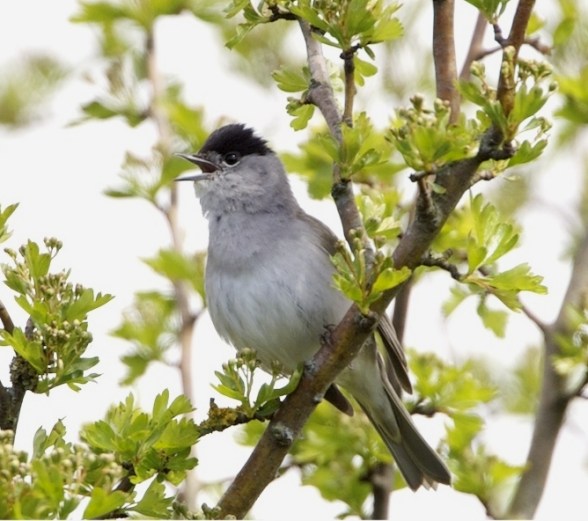
Sparrowhawk
About an hour later
while having coffee, Jean and I spotted an
unmistakable Sparrowhawk flying low across the garden.
We watched it circle high overhead before settling in
a tree. From its size I would guess it was a female.
Goldcrest
Finally, we had a
Goldcrest busily feeding in our neighbour's Silver
Birch tree for the second day running. Goldcrest is
not common in the garden, and good to see.
OTHER
NEWS
Siskins
in garden
Caroline French had
two Siskins on her feeders again and managed to
photograph one of them. She says she needn't have
bothered getting in any niger seed, as they were both
feeding on sunflower hearts!
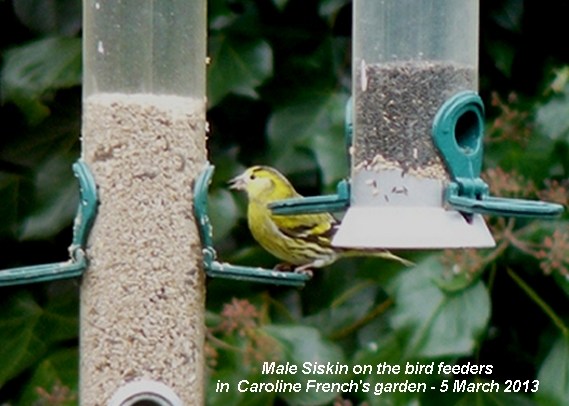
Another
Brimstone
Like Tony Wootton,
Caroline also saw her first Brimstone yesterday, this
one near East Meon.
Warblington
Farm
Malcolm Phillips went
over to Warblington today and found the Glossy Ibis
close to the path giving excellent close-up views for
anyone who has not yet seen or photographed the bird.
Whilst there Malcolm also saw a Chiffchaff, a
Song Thrush and a male Pheasant all in the same field
as the Ibis. Is it the Ibis or there something about
this field that attracts all these birds? Or is it
just lots of people watching? Curlew, Water Rail and
White Wagtail have also been seen while the Ibis has
been there.
Here
is Malcolm's Chiffchaff which could be an early
migrant, though it is impossible to say at this
stage
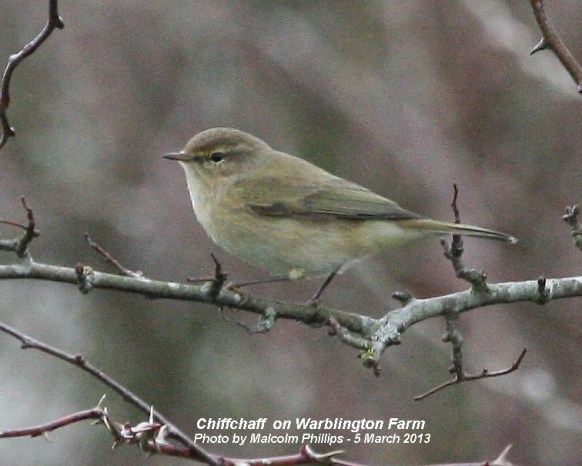
Brook
Meadow
Malcolm went back to
Brook Meadow where he got yet another sighting of a
Water Vole by the observation fence. He
followed it all the way down to the south bridge which
it swam under. Twenty mins later Malcolm saw what
could have been the same Water Vole on its way back.
This time it went to ground about 15yrds up from the
deep water sign. Malcolm saw the Long-tailed Tits
still collecting material for their nest and also
noticed the first flowers coming out on the
Marsh-marigold on the river bank in Palmer's Road
Copse.
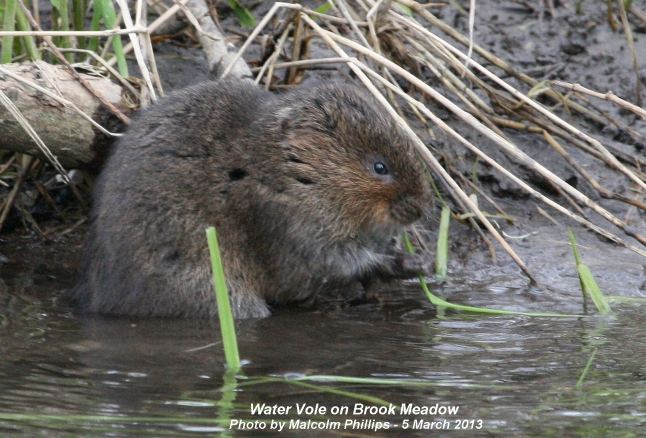
TUESDAY
MARCH 5 - 2013
EMSWORTH
Slipper
Millpond
Jean and I walked from
home to Emsworth Marina this morning, passing Slipper
Millpond on our way. The pond was very quiet with very
few birds and hardly any gulls. The main birds of
interest was a pair of adult Herring Gulls. Also, of
interest was a Greenshank feeding in the low
water Dolphin Lake to the west of the pond. I often
see Redshank feeding in the lake, but very rarely a
Greenshank.
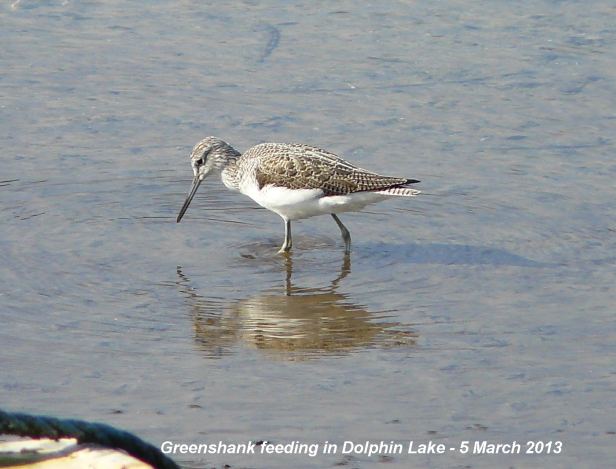
Spotted
Redshank
15:00 - Nore Barn.
About 2 hours to high water and the tide well in with
the stream filling The Spotted Redshank was on the mud
near the stream when I arrived but flew over the
saltmarshes to come to rest on the shore around the
point to Nore Barn Creek. It was still there when I
left at about 15:30.
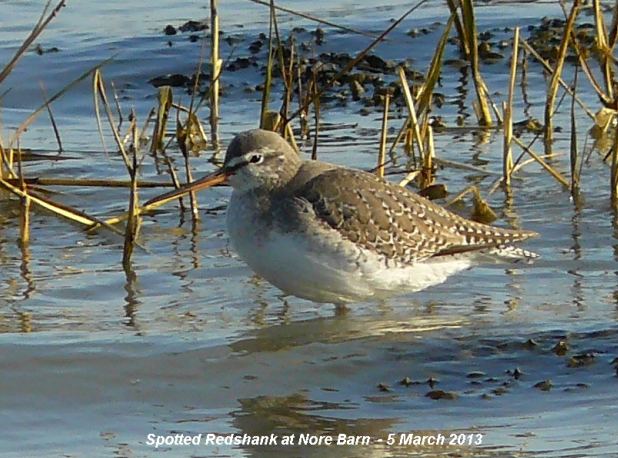
Hairy
Garlic leaves
Following negative
reports by the Havant Wildlife Group and by Ralph
Hollins I checked the usual spot for Hairy Garlic
leaves on the northern path. Just a few leaves were
showing, but not nearly so many as in previous years.
There is a much better show of Hairy Garlic leaves on
the path behind Lillywhite's Garage in Emsworth.
Herring
Gull nest
I met a lady
birdwatcher at Nore Barn who told me the pair of
Herring Gulls that nested on the roof of house number
50 Selangor Avenue last summer were back there again.
I checked on the way home, but did not see them.
First
Brimstone
Tony Wootton had a
male Brimstone butterfly over his Emsworth garden
today. This is the first I have heard of. Spring has
sprung !
Water
Voles
Malcolm Phillips had a
very good day for Water Voles on Brook Meadow. He saw
his first at the north east corner just where the path
from the meadow joins the river bank at 10.30am. The
next one was opposite the Deep Water sign at 11.30am.
Then he saw two more swimming together 30 yards up
from the observation fence at 12.05pm and again at
1.45pm again opposite the deep water sign. At 11.15am
Malcolm saw the Water Rail about 30yrds up from the
south bridge on the east bank.

OTHER
NEWS
Black-tailed
Godwits
14:30 - I went over to
North Hayling again today to have another look at the
Black-tailed Godwits in 'Texaco Bay'. I was about 2
hours later than yesterday and the tide was much
higher resulting in fewer birds feeding in the bay.

However, they were a
lot closer than yesterday and I was able to see the
colour-rings more clearly. I counted 130, all actively
feeding with lots of spurting clearly visible.
Here is a photo of one bird I caught doing it.
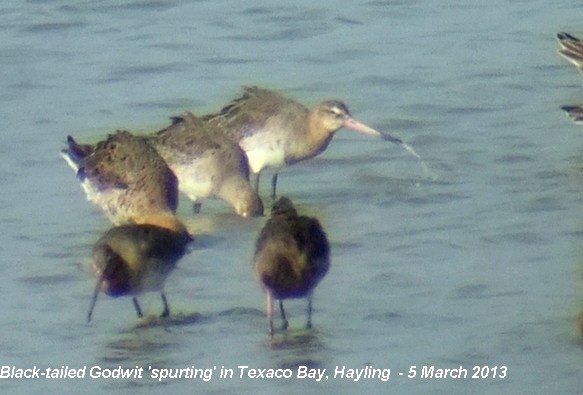
I watched them for
about 10 minutes before they all went up and flew east
over the bridge onto the Northney shore. I had a look
at them on the Northney shore, where I counted 220
plus a few more which were out of sight.
Over the two days I
have logged a total of 22 colour-ringed godwits, most
of them Farlington ringed birds. I have still to go
through the list to check with my own records before
sending them to Pete Potts.
Osprey
Decoys
Ralph Hollins queries
as to why plastic Ospreys were put in the man-made
Osprey nest on one of the old landing light poles at
Thornham Marshes on Thorney Island. The nest platforms
are a good idea and should catch the keen eye of any
Osprey visiting the area, but the plastic decoys,
which must be firmly attached to the nests, would
surely get in the way of any prospective nester. See
Ralph's musings on . . . http://ralph-hollins.net/Diary.htm
Ed Rowsell from
Chichester Harbour Conservancy explains
"The decoys are
actually the idea of Roy Dennis of the Highland
Wildlife Foundation, and have apparently been used
successfully in other areas. The reasoning is that
Osprey when settling in a new area seek confirmation
that it is a suitable place to nest, with this in mind
the artificial nests are made to resemble nests that
were used in the previous season, i.e. filled up level
to the top with material rather than formed into a
nest bowl. The decoys are designed to add to this
subterfuge, as Osprey are known to attempt to displace
other pairs from nest sites. There are actually 2
platforms on the site and the decoys are installed in
one, they are designed to be quickly removed if real
birds are showing an interest. Out of interest the
decoys are actually polystyrene, so will have a bit of
give if an Osprey strikes them. They were created by
one of our rangers. Just getting the platforms noticed
by passing osprey would be a great starting point, we
think it is worth a trial, this will be the first
spring passage with the platforms in location. If
anyone sees Osprey taking an interest in the platforms
if they could let us know as soon as possible that
would be great."
MONDAY
MARCH 4 - 2013
RAVENS
NESTING
Following up a report
on Feb 9 by Richard Jones (Portsmouth City's warden
for Portsdown Hill) of a pair of Ravens taking an
interest in the Paulsgrove Chalkpit area, and later of
them nest building, Ralph Hollins visited the area on
Feb 28 and (from a point around SU 636 067) saw one
bird sitting on a nest built on the topmost arm of an
electricity pylon and a second bird keeping a watchful
eye on the nest from a perch on the cliff face where
it could be seen at no more than 20 metres from where
he was standing on the cliff top public path.
For more details, see Ralph's diary for Thu Feb 28 . .
. http://ralph-hollins.net/Diary.htm
I went over to have a
look at the nest this morning. It was easy to find, in
fact, the nest of twigs can be seen clearly as one
drives along the road in front of Forth Southwick. One
bird was snug on the nest with only its head showing
from time to time. There was no sign of the second
bird while I was there. The nest is quite a long way
from the path and is best seen with a telescope. I
tried taking photos, but the very bright sun was
almost directly behind the pylon, so the results were
poor. Here is a record shot showing the location of
the nest on the pylon.
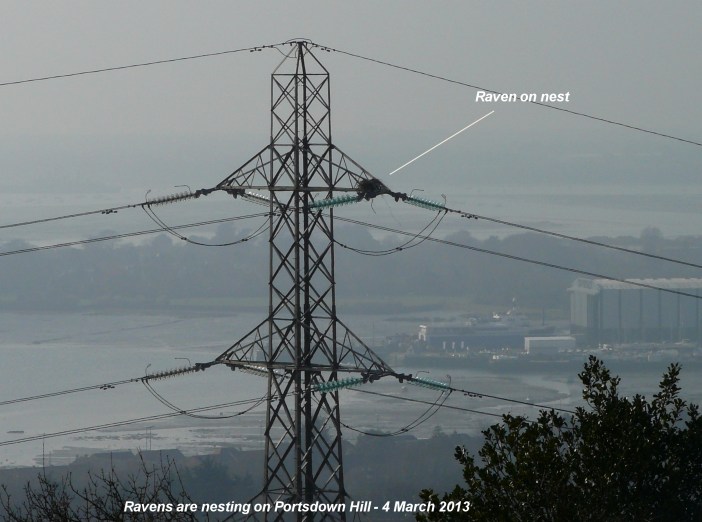
BUDDS
FARM PONDS
I went on to Budds
Farm to look for the two Scaup (male and female) that
Ralph also saw on Feb 28, but I could not find them.
There were plenty of other ducks on the pond,
including 7 Pochard (6 male and 1 female) and 17
Tufted Duck on the western pond. There were hundreds
of Dunlin feeding on the shore beneath the mound along
with a few Brent Geese, but numbers are certainly well
down.
BLACK-TAILED
GODWITS
My best experience of
the morning was undoubtedly finding a large flock of
252 Black-tailed Godwits including a at least 12
colour-ringed birds in 'Texaco Bay' on North Hayling
at about 12:30. This is a favourite spot for Godwits,
but it was my first visit this winter (which is almost
over). Here is just a few of them I got through my
scope.

I have not had time to
go through my colour-ringed photos, but will report on
them later. Using the scope, I could see lots of
'spurting' from the feeding godwits, though I was too
far away to capture any of the behaviour on camera. In
among the godwits were two superb Shelduck.
BUMBLEBEE
My wife alerted me to
the presence of a large Bumblebee resting on a white
towel hanging on the line in our back garden. I am
fairly sure it was a Buff-tail Bumblebee (Bombus
terrestris) from the single yellow bands on
the thorax and abdomen and its whitish tail. Its size
certainly suggested a queen which would be expected to
emerge at this time of the year to set up a nest.
Brian Lawrence also
saw what looks like a Buff-tail Bumblebee (Bombus
terrestris) feeding on Lungwort flowers in Lumley Road
today. From the pollen sacks I would assume this was a
worker providing for its nest, and what a worker from
the size of its pollen sacks.

WARBLINGTON
FARM
Glossy
Ibis
Malcolm Phillips went
to Warblington today to have another look at the
Glossy Ibis and got the following splendid image of
the bird showing its attractive green and purple
glossy plumage from which it gets is name.
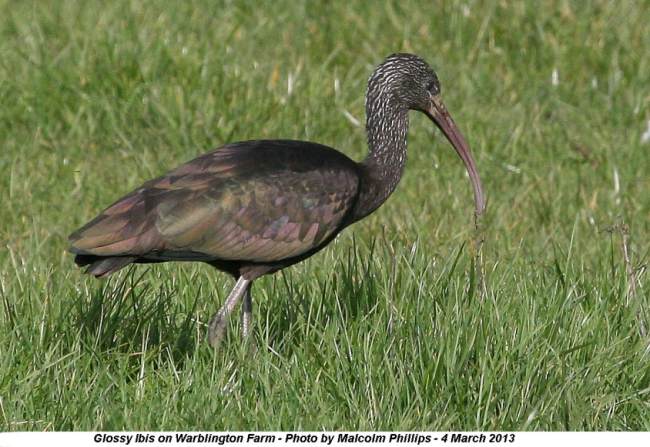
White
Wagtail
As if the Ibis was not
enough Malcolm also came away with a photo of what he
was told was a White Wagtail, though he professed
never having heard of the bird.

The White Wagtail was
also reported on Hoslist in the field with the Ibis by
Kevin Crisp who was probably the person who identified
the bird for Malcolm. White Wagtail (ssp alba) is
described in the Hampshire Bird Report as 'A scarce
spring and autumn passage migrant'. In 2010 only 67
birds were reported in Hampshire between March 14th
and May 4th, so the Warblington bird was a good
sighting and early spring migrant.
Water
Rail
No one reported the
Water Rail at Warblington today, but on Saturday (Mar
2) Richard Fairbank saw two Water Rails in the Glossy
Ibis field, plus a Fox out in the open. Take care Mr
Ibis!
WEEKEND
NEWS
Red-breasted
Goose on Thorney
Barry Collins reported
that the Red-breasted Goose has been showing well over
the past weekend on the airfield at Thorney Island
with ca. 800 Dark-bellied Brent Geese which have been
very restful all week and will soon be on there way
back to their breeding grounds.
Blackbird
song
Ralph Hollins reports
that Blackbird song was first reported at Durlston on
Jan 15 and in Emsworth on Jan 17 (by me), then again
at Durlston on Feb 3. More recently song was heard in
both Emsworth and Havant on Feb 25 and again at
Emsworth on Feb 28 and several times subsequently by
me. They are clearly starting up generally, though
later than usual.
'Pink'
Sweet Violets
On Feb 28 I found and
photographed what I thought were the pink form of
Sweet Violets that we regularly see in the western
section of Nore Barn Woods. However, Ralph Hollins
says what I saw were an intermediate form between the
normal violet colour and the pure pink form. The pure
pink flowers have been diminishing and may not appear
this year (choked out by Ivy!). See Ralph Hollins's
Weekly Summary at . . . http://ralph-hollins.net/Summary.htm

SATURDAY
MARCH 2 - 2013
BROOK
MEADOW
This afternoon, as I
was walking down Seagull Lane towards the northern
entrance to Brook Meadow, I met Graham Petrie, having
had what he described as a 'wonderful birding day'.
Not only did he get a good view of the Glossy Ibis at
Warblington Farm, but had his best ever views of the
Firecrest and the Water Rail near the observation
fence on Brook Meadow. I have met so many people with
the same story after seeing our beautiful birds. How
good it is that Brook Meadow can provide such
enjoyment. Graham's only disappointment was failing to
see a Water Vole. Well, try, try again!
Mallard
pair
A little way south of
the north bridge I passed the 'resident' pair of
Mallard swimming in the river. I assume the female
will be nesting somewhere on the river bank and,
hopefully, we can look forward to seeing her family of
ducklings in the spring.

Water
Rail
At about 3pm from the
main path through Brook Meadow, I had an excellent
view of the Water Rail, which was feeding on the river
bank immediately beneath the observation fence. I
watched it and took lots of photos for about 15
minutes before it moved into the mass of brambles to
rest and preen.
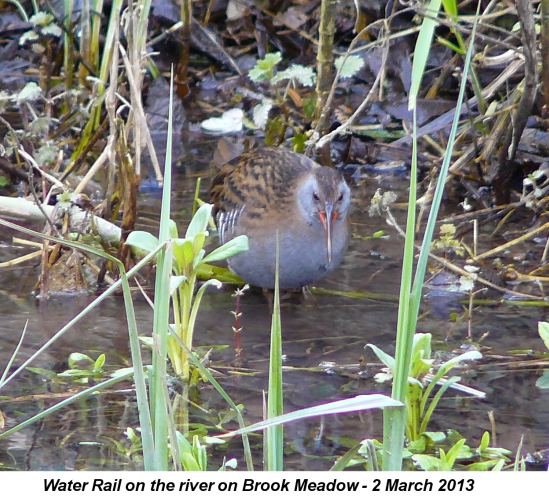
Firecrest
A little later I met
up with Ian Mears and Helen who had enjoyed a close-up
sighting of the male Firecrest in Palmer's Road Copse.
Here is a photo of what was probably the same bird
taken by Malcolm Phillips (its 'best friend') earlier
in the day.
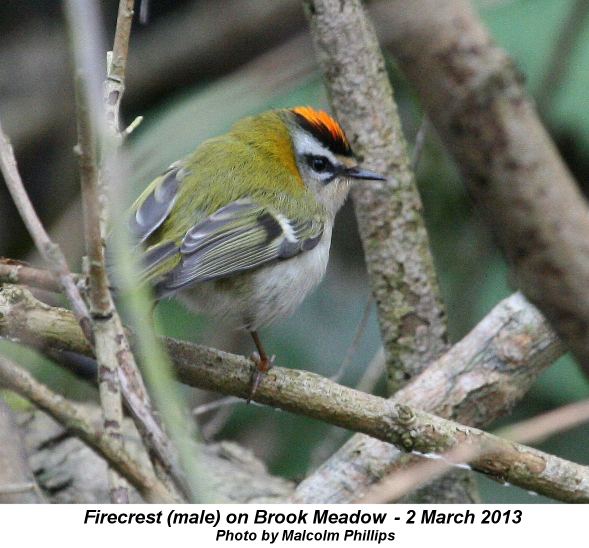
Water
Vole
My thanks to Ian and
Helen for pointing out the presence of a Water Vole
sitting happily on the west bank of the river opposite
the observation fence where I was standing at the
time. I watched it for a few minutes as it munched on
vegetation. It also had a couple of quick plunges into
the river before finally disappearing into the
bank.
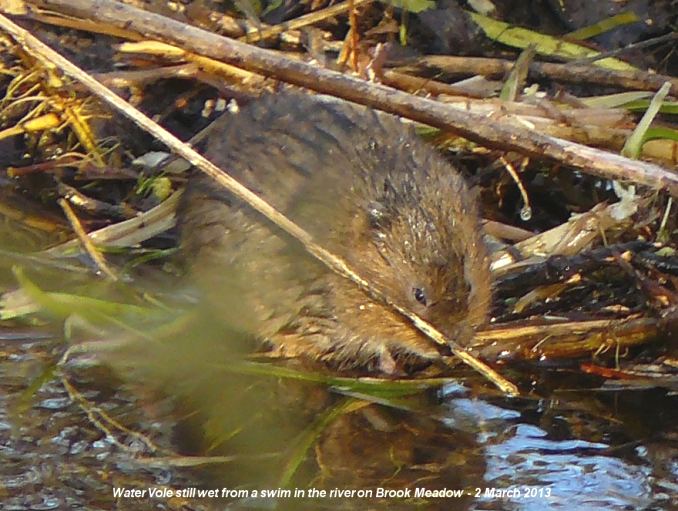
Malcolm had also seen
what was probably the same Water Vole during his
morning watch at the observation fence.
EMSWORTH
MILLPONDS
Mute
Swans
The resident pair of
Mute Swans were on Peter Pond this afternoon. There
was no sign of the intruding pair of swans that caused
such bother on Slipper Millpond yesterday.
Roy Hay asks if any
work has been done to raise the nesting site of the
Mute Swans on Peter Pond, as the nest has been flooded
over the last few years. In fact, David Gattrell, who
manages Peter Pond, has done a lot of work over the
years in raising the level of the island and this can
easily be seen from the road. However, last year the
swans persisted in building their nest on a lower part
of the island with the consequence that it became
swamped by high spring tides and the eggs were lost.
This
photo shows the swans trying to build up the level of
the nest last year
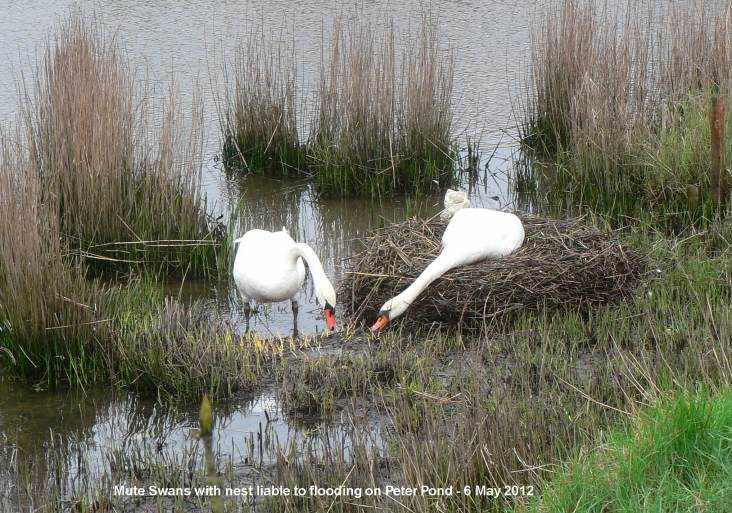
Great
Black-backed Gulls
The pair of Great
Black-backed Gulls was back on the centre raft on
Slipper Millpond, looking as if they intended to stay!
There was no sign of the Lesser Black-backed Gull that
was on the pond yesterday. Two's company three's a
crowd!

CHICHESTER
GRAVEL PITS
Ros Norton reported on
this morning's walk by the Havant Wildlife Group
including a sighting of a Bittern.
For the full report go
to . . . http://familyfellows.com/hwg-walk-reports-2013.htm
Bittern
For the second week
running the Havant Wildlife Group turned up a rare
bird. Their Bittern was not quite so rare and
unexpected as the Glossy Ibis they had last week at
Warblington Farm, but it was a good sighting
nevertheless. A Bittern was previously reported by
Geoff Lammas & Jude Barbour over West Trout Lake
on the SOS Sightings web site on 19 Feb. Richard
Somerscocks got the following photo of a Bittern in
flight at Chichester Gravel Pits at this time last
year. It could well have been the same bird that the
group saw today.
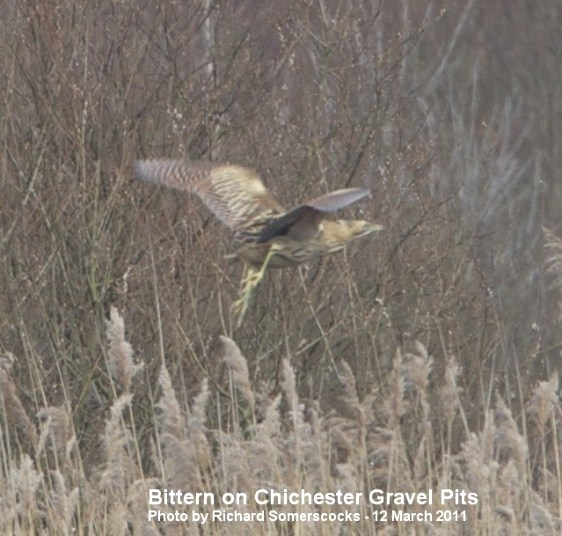
WARBLINGTON
FARM
Glossy
Ibis
The Glossy Ibis was
still showing well in the field on Warblington Farm
where it was first seen last Saturday by members of
the Havant Wildlife Group. Malcolm Phillips went over
to have another look at it today. Alex Berryman
reported that the Glossy Ibis was showing
exceptionally well in a field south of the cemetery
for half an hour this morning before returning to its
favoured spot to the east of the cemetery extension.
Here is Alex's super photo of the bird - the best I
have seen by far.
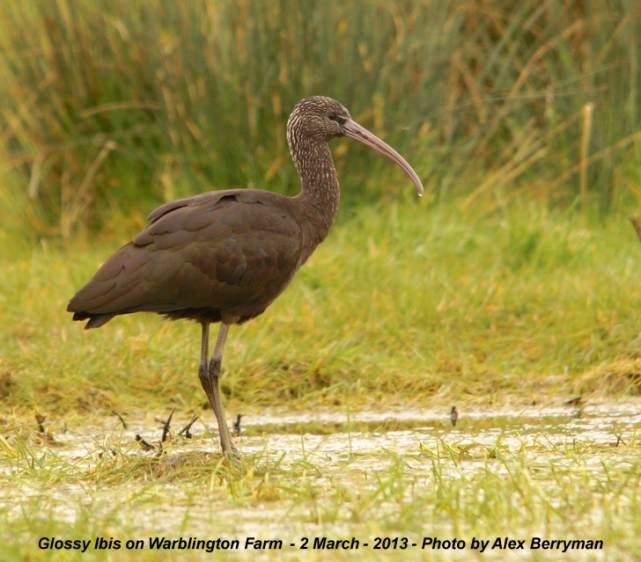
Water
Rail
Malcolm Phillips also
saw a Water Rail in the same field as the Ibis. As far
as I am aware, this was a first for this site. Ralph
Hollins confirms that Water Rail is a new addition to
the bird inventory of Warblington Farm - though he
thinks it is more than likely that birds have visited
with good habitat for them along the two streams plus
the cress beds and marshy SSSI.

SISKINS
IN GARDENS
Yesterday's report of
Siskins in Caroline French's garden prompted two
replies. Mike West told me that his daughter, who
lives at Liss, has had over a dozen Siskins on her
garden feeders over the past month. Mike sent the
following photo of a male Siskin on what looks like a
sunflower heart feeder.
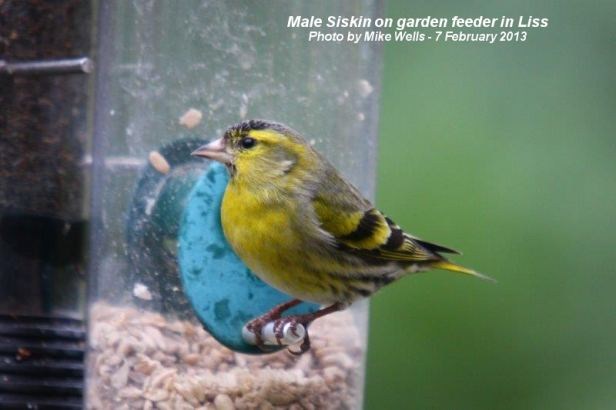
John Walton, who lives
in the Cowplain end of Waterlooville, has had a Siskin
visiting his sunflower heart feeders intermittently
this year, including one this morning.
FRIDAY
MARCH 1 - 2013
SLIPPER
MILLPOND
There was quite a lot
of activity on Slipper Millpond when I walked round
the pond this morning.
Mute
Swans
The resident male Mute
Swan from the Peter Pond pair was relentlessly
pursuing what I assume was the male of an intruding
Mute Swan pair. The resident male chased the intruder
with the standard threatening posture of wings raised
and head down.
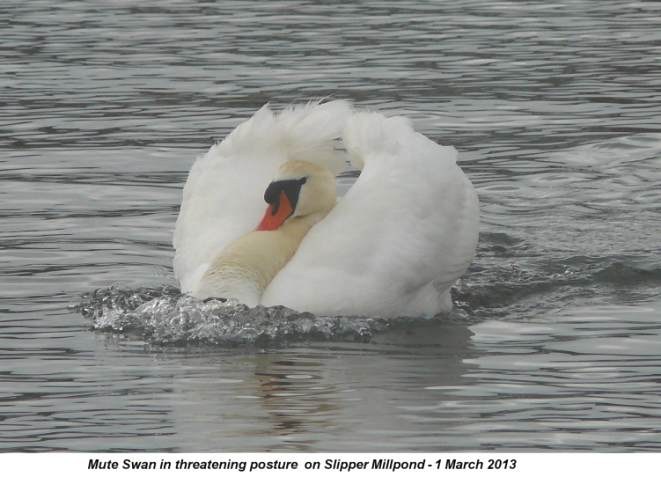
The
chase never got really violent, though there were
several skirmishes.
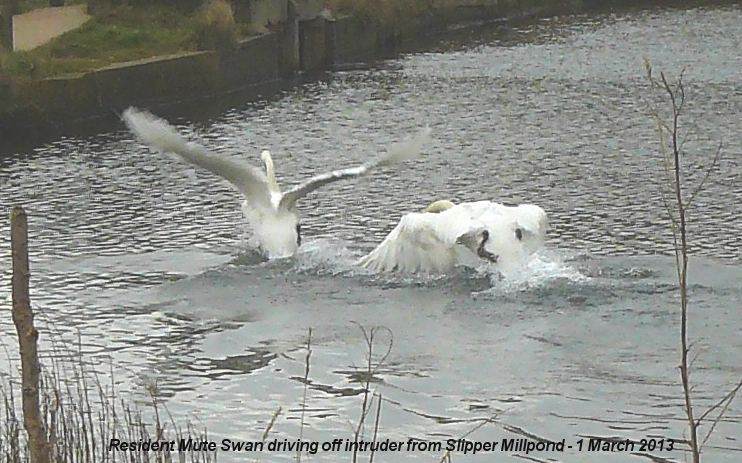
The chase continued
for the whole time I was present and was still going
on when I left with the intruding swans still hanging
on. A second pair of Mute Swans have nested on Slipper
Millpond in previous years, though never successfully.
We shall see what happens this year.
Lesser
Black-backed Gull
A very fine adult
Lesser Black-backed Gull in breeding plumage was on
the south raft on Slipper Millpond. Note its bright
yellow legs and feet, which clearly distinguishes it
from the larger Great Black-backed Gull which has pink
legs and feet. The very dark back of this bird
suggests it is of the Danish race
intermedius which breeds in SW
Scandinavia. The birds of the British race
graellsii has slate grey upper parts.
Both races winter in Western Europe and south to West
Africa, so can be seen in this area.
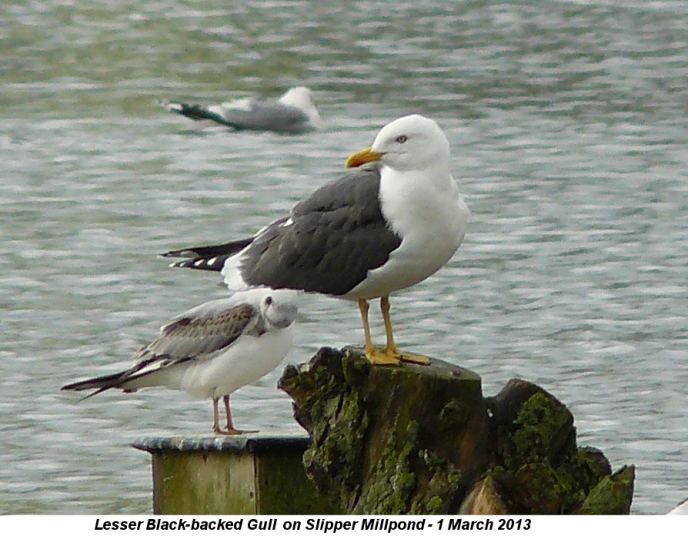
Little
Grebes
Two Little Grebes were
fishing in the southern part of the pond. I suspect
they were a pair as I heard one of them giving the
loud whinnying call. It would be nice if they stayed
to nest on the pond, but my guess is that they are
visitors from Thorney Little Deeps.
Little
Egret
A watched a Little
Egret fishing in Dolphin Lake which is adjacent to
Slipper Millpond. It had fine breeding plumes which
were much sought after for the costume trade in the
19th Century and which almost led to the extinction of
this beautiful bird.
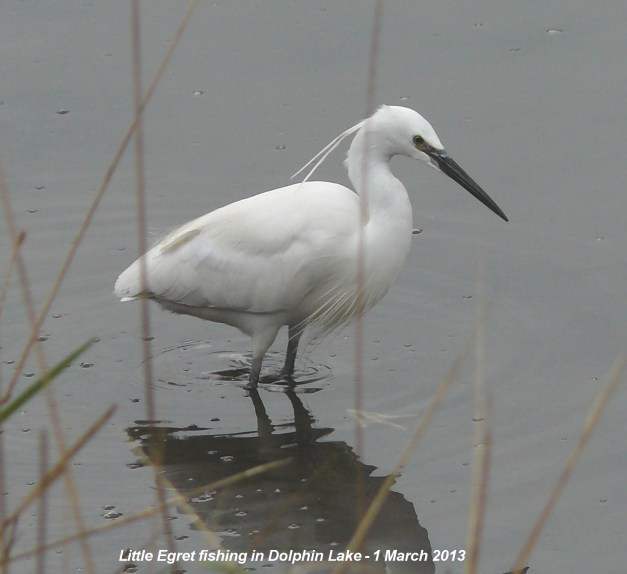
BROOK
MEADOW
I walked back through
Palmer's Road Copse where I met Malcolm Phillips who
was having a good morning for birds. He had already
seen the resident male Firecrest in the now
regular area to the west of the main path through
Palmer's Road Copse
Water
Rail
Malcolm also had some
fleeting glimpses of the equally resident, but
elusive, Water Rail. While I was there the Water Rail
showed itself several times as it slunk around in the
tangled clump of brambles and ivy on the river bank
just south of the observation fence. What a cracking
bird this is. This is the best image Malcolm could
get.

Long-tailed
Tit
Malcolm got this
excellent photo of a Long-tailed Tit collecting lichen
for its nest. Birds of the Western Palearctic states
that the nest of Long-tailed Tits is a compact, domed
structure of moss woven with cobwebs and hair and
covered on the outside with camouflaging greyish
lichen. So that is what Malcolm's bird was collecting
lichen for.
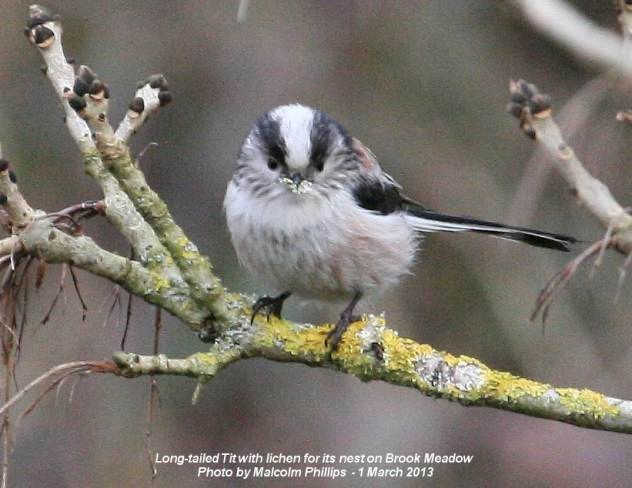
Water
Vole
Malcolm got a good
sighting of a Water Vole north of the sluice gate at
about 12 noon. That was sighting number 45 for 2013 so
far!
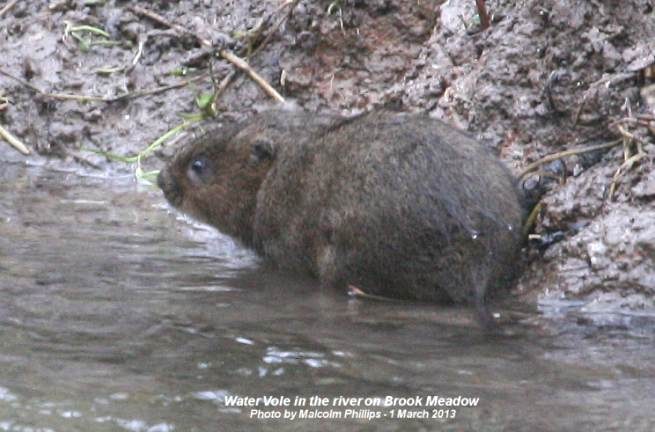
SISKINS
IN GARDEN
This morning at about
8am Caroline French had a single male Siskin on one of
her garden feeders, and then, about an hour later, a
single female Siskin turned up. This was the first
time Caroline had seen Siskins in her garden in 6
years at the house. They were feeding on kibbled
sunflower hearts, although she was tempted to supply
some nyger seed as this is a favourite.
I have just checked my
own garden bird records and I have only seen Siskins
in Feb and Mar 2004. On one magical day I had three on
the feeders! That must have been a good year. Here is
my photo of a male on a peanut holder in March 2004.
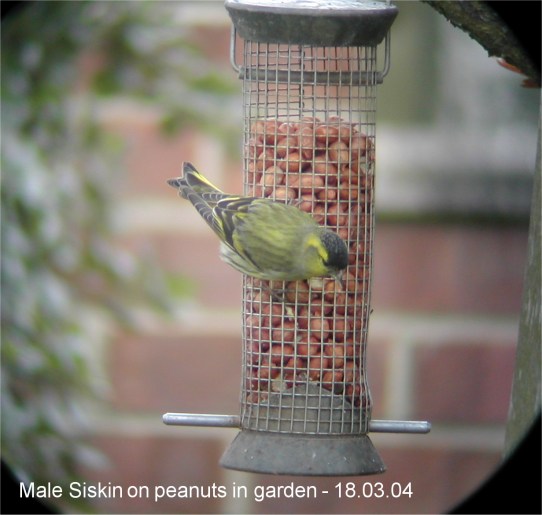
Caroline added that
the BTO are featuring Siskin as the March 'Bird of the
Month' at http://blx1.bto.org/atlas/
They say,
"The winter of 2012/13 already appears to be a bumper
year for Siskins in gardens. From the sudden rise in
garden activity, it looks as if stocks of sitka spruce
and alder seed had become seriously depleted by early
February. From previous years' data, we would not
expect numbers to reach a peak until late in March, so
this may be a good time to stock up on sunflower
hearts or nyger seed!" So, please keep a good look out
for them and let me know if you get any Siskins in
your garden - with a photo if possible!
For
earlier observations go to . . . February
16-28